Reduced-Order Modeling (ROM) of a Segmented Plug-Flow Reactor (PFR) for Hydrogen Separation in Integrated Gasification Combined Cycles (IGCC)
Abstract
1. Introduction
1.1. General Overview
1.2. The Objectives of the Study
1.3. Novelty and Added Knowledge
1.4. The Structure of the Manuscript
2. Research Method
2.1. Connection to Real-Life Application
2.2. Computer Modeling Tool
2.3. Controllable Variables
2.4. Simplifying Assumptions and Their Implications
2.5. Flow Setup
3. General Model Settings
3.1. Fixing Common Parameters
3.2. Underlying Geometry
3.3. Fixed Conditions
4. Hydrogen Permeation Metrics
4.1. Membrane Length
4.2. Average Hydrogen Permeation Mass Flux
4.3. Log Mean Pressure-Square-Root Difference
4.4. Global Apparent Permeance
4.5. Efficiency Factor
5. Results
5.1. Base Case and Spatial Resolution Test
5.2. Influence of Temperature
- 300 °C (base);
- 350 °C;
- 400 °C;
- 500 °C;
- 600 °C;
- 700 °C;
- 800 °C.
5.3. Influence of Retentate Pressure
- 40 atm (base);
- 45 atm;
- 50 atm;
- 60 atm;
- 70 atm;
- 80 atm;
- 100 atm;
- 120 atm.
5.4. Influence of Permeate Pressure
- 20 atm (base);
- 17.5 atm;
- 15 atm;
- 10 atm;
- 5 atm;
- 1 atm;
- 0.5 atm;
- 0.2 atm.
5.5. Profiles with Extreme Design Variables
6. Discussion
6.1. The Contributions of the Study
6.2. Ideal-Gas Law and Compressibility Factor
6.3. Self-Validation
6.4. Priority Design Chart
7. Conclusions
Funding
Data Availability Statement
Conflicts of Interest
Correction Statement
Appendix A. Continuous Plug-Flow Reactor Modeling
Appendix B. Modeling Hydrogen Permeation
Appendix B.1. Segmental Plug-Flow Reactor
Appendix B.2. Modeling Algorithm
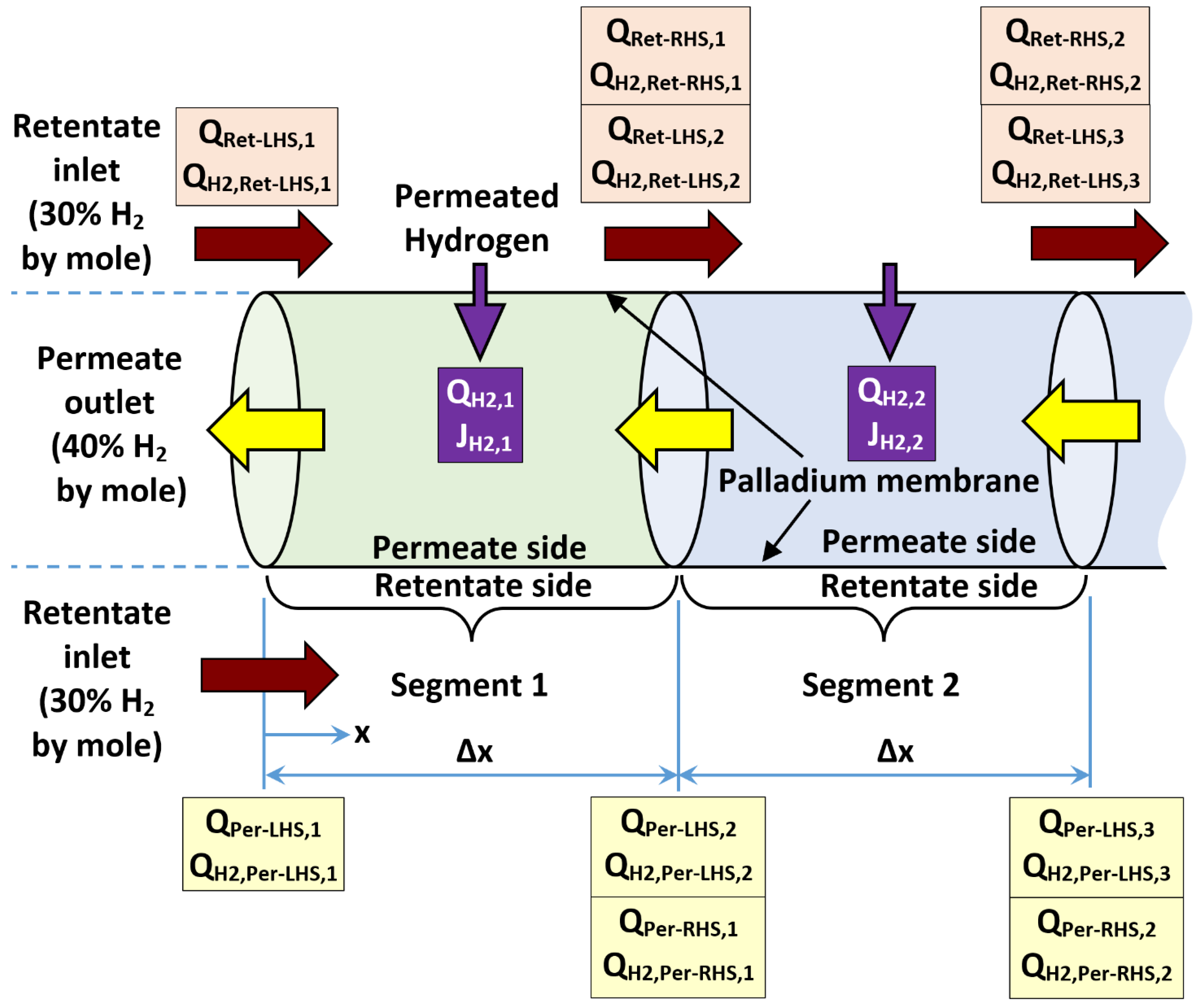
- (a)
- Start with a known hydrogen mole fraction in the retentate at the LHS (XH2,Ret-LHS,i), standard volume flow rate of retentate at the LHS (QRet-LHS,i), hydrogen mole fraction of permeate at the LHS (XH2,Per-LHS,i), and standard volume flow rate of permeate at the LHS (QPer-LHS,i) of the segment (say segment number i).
- (b)
- Compute (QH2,Per-LHS,i), which is the standard volume flow rate of the hydrogen content in the permeate stream at the LHS of the current segment being analyzed (say segment i), as follows:
- (c)
- Compute (ΔPH20.5)LHS,i, which is the difference in the partial pressures of hydrogen raised to the power of 0.5 (this difference is the driving force for hydrogen permeation through the palladium membrane) at the LHS of the current segment being analyzed (say segment i), as follows:
- (d)
- Compute (
JH2,i), which is a predicted (first-iteration) segment-level molar flux of permeating hydrogen through the palladium membrane based on the conditions at LHS of the current segment being analyzed (say segment i), as follows:
- (e)
- Convert the LHS-based first-iteration molar flux (
JH2,i) to a predicted (first-iteration) segment-level standard volume flow rate of permeating hydrogen (QH2,i) for the current segment being analyzed (say segment i).
- (f)
- Compute (
XH2,Ret-RHS,i) and (XH2,Per-RHS,i), which are predicted (first-iteration) mole fractions of hydrogen in the retentate stream and the permeate stream, respectively, at the RHS of the current segment being analyzed (say segment i), as follows:
- (g)
- Compute (ΔPH20.5)RHS,i, which is the difference in the partial pressures of hydrogen raised to the power of 0.5 (as the driving force for hydrogen permeation) at the RHS of the current segment being analyzed (say segment i), as follows:
- (h)
- Compute (ΔPH20.5)i, which is the difference in the partial pressures of hydrogen raised to the power of 0.5 assigned to the current segment being analyzed (say segment i). It is taken as the arithmetic average of the LHS value and the RHS value, as follows:
- (i)
- Compute (JH2,i), which is a corrected (second-iteration) segment-level molar flux of permeating hydrogen through the palladium membrane, which includes driving forces for permeation at both sides of the current segment being analyzed (say segment i), as follows:
- (j)
- Convert the corrected, segment-level molar flux (JH2,i) to a corresponding updated (refined) segment-level standard volume flow rate of permeating hydrogen (QH2,i) for the current segment being analyzed (say segment i), as follows:
- (k)
- Compute (RH2,i), which is the hydrogen recovery due to the current segment being analyzed (say segment i), as follows:
- (l)
- Optional: Compute (), which is the cumulative hydrogen recovery, due to all previous segments of the membrane reactor in addition to the current segment being analyzed (say segment i), as follows:
- (m)
- Compute (QRet-RHS,i) and (QH2,Ret-RHS,i), which are the standard volume flow rate of the retentate stream and the hydrogen content in that retentate stream, respectively, at the RHS of the current segment being analyzed (say segment i), as follows:
- (n)
- Compute (XH2,Ret-RHS,i), which is the corrected (second-iteration) mole fraction of hydrogen in the retentate stream at the RHS of the current segment being analyzed (say segment i), as follows:
- (o)
- Compute (QPer-RHS,i) and (QH2,Per-RHS,i), which are the standard volume flow rate of the permeate stream and the hydrogen content in that permeate stream, respectively, at the RHS of the current segment being analyzed (say segment i), as follows:
- (p)
- Compute (XH2,Per-RHS,i), which is the corrected (second-iteration) mole fraction of hydrogen in the permeate stream at the RHS of the current segment being analyzed (say segment i), as follows:
- (q)
- Set the obtained RHS conditions of the current segment being analyzed (say segment i) as LHS conditions at the next adjacent segment to be analyzed (segment i + 1), and repeat the computation procedure sequentially for all remaining segments until the last membrane segment (segment n).
- (ΔPH20.5)LHS,i;
JH2,i;QH2,i;XH2,Ret-RHS,i andXH2,Per-RHS,i;- (ΔPH20.5)RHS,i;
- (ΔPH20.5)i;
- JH2,i;
- QH2,i;
- RH2,i;
- Optional:
- QRet-RHS,i and QH2,Ret-RHS,i;
- XH2,Ret-RHS,i;
- QPer-RHS,i and QH2,Per-RHS,i;
- XH2,Per-RHS,i.
- (r)
- Compute (), which is the cumulative hydrogen recovery at the last segment. It is the overall hydrogen recovery by the entire membrane reactor, and it is obtained by simply adding the segment-level hydrogen recovery (RH2,i) for all the (n) segments of the membrane reactor. The total cumulative value is the target hydrogen recovery (β). Therefore,
References
- Bell, D.A.; Towler, B.F.; Fan, M. Coal Gasification and Its Applications; William Andrew/Elsevier: Oxford, UK, 2011; ISBN 978-1-4377-7851-9. [Google Scholar]
- Marzouk, O.A.; Huckaby, E.D. Assessment of Syngas Kinetic Models for the Prediction of a Turbulent Nonpremixed Flame. In Proceedings of the Fall Meeting of the Eastern States Section of the Combustion Institute 2009, College Park, ML, USA, 18–21 October 2009; pp. 726–751. [Google Scholar] [CrossRef]
- Couto, N.; Rouboa, A.; Silva, V.; Monteiro, E.; Bouziane, K. Influence of the Biomass Gasification Processes on the Final Composition of Syngas. Energy Procedia 2013, 36, 596–606. [Google Scholar] [CrossRef]
- Żogała, A. Equilibrium Simulations of Coal Gasification—Factors Affecting Syngas Composition. J. Sustain. Min. 2014, 13, 30–38. [Google Scholar] [CrossRef]
- Wagner, N.J.; Coertzen, M.; Matjie, R.H.; van Dyk, J.C. Chapter 5—Coal Gasification. In Applied Coal Petrology; Suárez-Ruiz, I., Crelling, J.C., Eds.; Elsevier: Burlington, NJ, USA, 2008; pp. 119–144. ISBN 978-0-08-045051-3. [Google Scholar]
- Guo, X.; Tang, Y.; Wang, Y.; Eble, C.F.; Finkelman, R.B.; Li, P. Evaluation of Carbon Forms and Elements Composition in Coal Gasification Solid Residues and Their Potential Utilization from a View of Coal Geology. Waste Manag. 2020, 114, 287–298. [Google Scholar] [CrossRef]
- Wang, Z.; Yang, J.; Li, Z.; Xiang, Y. Syngas Composition Study. Front. Energy Power Eng. China 2009, 3, 369–372. [Google Scholar] [CrossRef]
- Al-Zareer, M.; Dincer, I.; Rosen, M.A. Influence of Selected Gasification Parameters on Syngas Composition from Biomass Gasification. J. Energy Resour. Technol. 2018, 140, 041803. [Google Scholar] [CrossRef]
- Jayanarasimhan, A.; Pathak, R.M.; Shivapuji, A.M.; Rao, L. Tar Formation in Gasification Systems: A Holistic Review of Remediation Approaches and Removal Methods. ACS Omega 2024, 9, 2060–2079. [Google Scholar] [CrossRef]
- NETL, [National Energy Technology Laboratory of the United States Department of Energy]. Reactions & Transformations. Available online: https://netl.doe.gov/research/coal/energy-systems/gasification/gasifipedia/reaction-transformations (accessed on 5 May 2022).
- Frolov, S.M.; Panin, K.S.; Smetanyuk, V.A. Gasification of Liquid Hydrocarbon Waste by the Ultra-Superheated Mixture of Steam and Carbon Dioxide: A Thermodynamic Study. Energies 2024, 17, 2126. [Google Scholar] [CrossRef]
- Talmadge, M.; Biddy, M.; Dutta, A.; Jones, S.; Meyer, A. Syngas Upgrading to Hydrocarbon Fuels Technology Pathway; National Renewable Energy Laboratory (NREL), and Pacific Northwest National Laboratory (PNNL) of the United States Department of Energy (DoE): Richland, WA, USA, 2013.
- Lin, S.; Harada, M.; Suzuki, Y.; Hatano, H. Hydrogen Production from Coal by Separating Carbon Dioxide during Gasification. Fuel 2002, 81, 2079–2085. [Google Scholar] [CrossRef]
- Vow (ETIA SAS)|Syngas-High Energy Pyrolysis Gas for Power Applications. Available online: https://www.biogreen-energy.com/syngas (accessed on 6 May 2025).
- Suxing, S.; Yu, X.; Li, J.; Liu, X.; Sui, L.; Zhang, J.; Fu, Z.; Shao, Y. Effects of Hydrogen Addition on the Thermal Performance and Emissions of Biomass Syngas Combustion in a Horizontal Boiler. Energies 2024, 17, 2632. [Google Scholar] [CrossRef]
- Marzouk, O.A. Portrait of the Decarbonization and Renewables Penetration in Oman’s Energy Mix, Motivated by Oman’s National Green Hydrogen Plan. Energies 2024, 17, 4769. [Google Scholar] [CrossRef]
- Timilsina, M.S.; Chaudhary, Y.; Shah, A.K.; Lohani, S.P.; Bhandari, R.; Uprety, B. Syngas Composition Analysis for Waste to Methanol Production: Techno-Economic Assessment Using Machine Learning and Aspen Plus. Renew. Energy 2024, 228, 120574. [Google Scholar] [CrossRef]
- Costa, E. Industry 5.0 and SDG 9: A Symbiotic Dance towards Sustainable Transformation. Sustain. Earth Rev. 2024, 7, 4. [Google Scholar] [CrossRef]
- Marzouk, O.A.; Nayfeh, A.H. Mitigation of Ship Motion Using Passive and Active Anti-Roll Tanks. In Proceedings of the ASME 2007 International Design Engineering Technical Conferences and Computers and Information in Engineering Conference (IDETC-CIE 2007), ASME [American Society of Mechanical Engineers]. Las Vegas, NV, USA, 20 May 2009; pp. 215–229. [Google Scholar] [CrossRef]
- TGG, [The Global Goals] SDG 9|Goal 9: Industry, Innovation and Infrastructure. Available online: https://globalgoals.org/goals/9-industry-innovation-and-infrastructure (accessed on 3 May 2025).
- Marzouk, O.A.; Nayfeh, A.H. Control of Ship Roll Using Passive and Active Anti-Roll Tanks. Ocean Eng. 2009, 36, 661–671. [Google Scholar] [CrossRef]
- Kynčlová, P.; Upadhyaya, S.; Nice, T. Composite Index as a Measure on Achieving Sustainable Development Goal 9 (SDG-9) Industry-Related Targets: The SDG-9 Index. Appl. Energy 2020, 265, 114755. [Google Scholar] [CrossRef]
- Marzouk, O.A. Summary of the 2023 (1st Edition) Report of TCEP (Tracking Clean Energy Progress) by the International Energy Agency (IEA), and Proposed Process for Computing a Single Aggregate Rating. E3S Web Conf. 2025, 601, 00048. [Google Scholar] [CrossRef]
- Küfeoğlu, S. (Ed.) SDG-9: Industry, Innovation and Infrastructure. In Emerging Technologies: Value Creation for Sustainable Development; Springer International Publishing: Cham, Switzerland, 2022; pp. 349–369. ISBN 978-3-031-07127-0. [Google Scholar]
- Cavo, M.; Rivarolo, M.; Gini, L.; Magistri, L. An Advanced Control Method for Fuel Cells—Metal Hydrides Thermal Management on the First Italian Hydrogen Propulsion Ship. Int. J. Hydrogen Energy 2023, 48, 20923–20934. [Google Scholar] [CrossRef]
- Marzouk, O.A. Expectations for the Role of Hydrogen and Its Derivatives in Different Sectors through Analysis of the Four Energy Scenarios: IEA-STEPS, IEA-NZE, IRENA-PES, and IRENA-1.5 °C. Energies 2024, 17, 646. [Google Scholar] [CrossRef]
- Villavicencio Calzadilla, P.; Mauger, R. The UN’s New Sustainable Development Agenda and Renewable Energy: The Challenge to Reach SDG7 While Achieving Energy Justice. J. Energy Nat. Resour. Law 2018, 36, 233–254. [Google Scholar] [CrossRef]
- Marzouk, O.A. Power Density and Thermochemical Properties of Hydrogen Magnetohydrodynamic (H2MHD) Generators at Different Pressures, Seed Types, Seed Levels, and Oxidizers. Hydrogen 2025, 6, 31. [Google Scholar] [CrossRef]
- Estevão, J.; Lopes, J.D. SDG7 and Renewable Energy Consumption: The Influence of Energy Sources. Technol. Forecast. Soc. Change 2024, 198, 123004. [Google Scholar] [CrossRef]
- Marzouk, O.A. Jatropha Curcas as Marginal Land Development Crop in the Sultanate of Oman for Producing Biodiesel, Biogas, Biobriquettes, Animal Feed, and Organic Fertilizer. Rev. Agric. Sci. 2020, 8, 109–123. [Google Scholar] [CrossRef] [PubMed]
- Marcillo-Delgado, J.C.; Ortego, M.I.; Pérez-Foguet, A. A Compositional Approach for Modelling SDG7 Indicators: Case Study Applied to Electricity Access. Renew. Sustain. Energy Rev. 2019, 107, 388–398. [Google Scholar] [CrossRef]
- Marzouk, O.A. Facilitating Digital Analysis and Exploration in Solar Energy Science and Technology through Free Computer Applications. Eng. Proc. 2022, 31, 75. [Google Scholar] [CrossRef]
- Halder, P.; Babaie, M.; Salek, F.; Haque, N.; Savage, R.; Stevanovic, S.; Bodisco, T.A.; Zare, A. Advancements in Hydrogen Production, Storage, Distribution and Refuelling for a Sustainable Transport Sector: Hydrogen Fuel Cell Vehicles. Int. J. Hydrogen Energy 2024, 52, 973–1004. [Google Scholar] [CrossRef]
- Marzouk, O.A. Growth in the Worldwide Stock of E-Mobility Vehicles (by Technology and by Transport Mode) and the Worldwide Stock of Hydrogen Refueling Stations and Electric Charging Points between 2020 and 2022. In Construction Materials and Their Processing; Key Engineering Materials; Trans Tech Publications Ltd.: Bäch, Switzerland, 2023; Volume 972, pp. 89–96. ISBN 978-3-0364-0498-1. [Google Scholar] [CrossRef]
- Jayakumar, A.; Madheswaran, D.K.; Kannan, A.M.; Sureshvaran, U.; Sathish, J. Can Hydrogen Be the Sustainable Fuel for Mobility in India in the Global Context? Int. J. Hydrogen Energy 2022, 47, 33571–33596. [Google Scholar] [CrossRef]
- Mahadevia, D.; Mukhopadhyay, C.; Lathia, S.; Gounder, K. The Role of Urban Transport in Delivering Sustainable Development Goal 11: Learning from Two Indian Cities. Heliyon 2023, 9, e19453. [Google Scholar] [CrossRef] [PubMed]
- Marzouk, O.A. Toward More Sustainable Transportation: Green Vehicle Metrics for 2023 and 2024 Model Years. In Intelligent Sustainable Systems; Nagar, A.K., Jat, D.S., Mishra, D.K., Joshi, A., Eds.; Lecture Notes in Networks and Systems; Springer Nature: Singapore, 2024; Volume 817, pp. 261–272. ISBN 978-981-9978-85-4. [Google Scholar] [CrossRef]
- DESA, [United Nations Department of Economic and Social Affairs]. Sustainable Transport (SDG 11). Available online: https://sdgs.un.org/topics/sustainable-transport (accessed on 3 May 2025).
- Marzouk, O.A. Recommended LEED-Compliant Cars, SUVs, Vans, Pickup Trucks, Station Wagons, and Two Seaters for Smart Cities Based on the Environmental Damage Index (EDX) and Green Score. In Innovations in Smart Cities Applications Volume 7; Ben Ahmed, M., Boudhir, A.A., El Meouche, R., Karaș, İ.R., Eds.; Lecture Notes in Networks and Systems; Springer Nature: Cham, Switzerland, 2024; Volume 906, pp. 123–135. ISBN 978-3-031-53823-0. [Google Scholar] [CrossRef]
- Franco, S. Sustainable Cities and Communities: The Road towards SDG 11. TeMA—J. Land Use Mobil. Environ. 2022, 15, 341–344. [Google Scholar] [CrossRef]
- Mulibana, L.; du Toit, J. Transport Planning Research Toward Implementing SDG 11 in South Africa. In SDGs in Africa and the Middle East Region; Leal Filho, W., Abubakar, I.R., da Silva, I., Pretorius, R., Tarabieh, K., Eds.; Springer International Publishing: Cham, Switzerland, 2022; pp. 1–24. ISBN 978-3-030-91260-4. [Google Scholar]
- Marzouk, O.A. Zero Carbon Ready Metrics for a Single-Family Home in the Sultanate of Oman Based on EDGE Certification System for Green Buildings. Sustainability 2023, 15, 13856. [Google Scholar] [CrossRef]
- Liu, H.; Lu, H.; Hu, H. CO2 Capture and Mineral Storage: State of the Art and Future Challenges. Renew. Sustain. Energy Rev. 2024, 189, 113908. [Google Scholar] [CrossRef]
- Marzouk, O.A. Assessment of Global Warming in Al Buraimi, Sultanate of Oman Based on Statistical Analysis of NASA POWER Data over 39 Years, and Testing the Reliability of NASA POWER against Meteorological Measurements. Heliyon 2021, 7, e06625. [Google Scholar] [CrossRef]
- Doni, F.; Gasperini, A.; Soares, J.T. What Is the SDG 13? In SDG13—Climate Action: Combating Climate Change and Its Impacts; Emerald Publishing Limited: Leeds, UK, 2020; pp. 21–30. ISBN 978-1-78756-915-7. [Google Scholar]
- Marzouk, O.A. Evolution of the (Energy and Atmosphere) Credit Category in the LEED Green Buildings Rating System for (Building Design and Construction: New Construction), from Version 4.0 to Version 4.1. J. Infrastruct. Policy Dev. 2024, 8, 5306. [Google Scholar] [CrossRef]
- TGG, [The Global Goals] SDG 13|Goal 13: Climate Action. Available online: https://globalgoals.org/goals/13-climate-action (accessed on 3 May 2025).
- Bakirci, M. Smart City Air Quality Management through Leveraging Drones for Precision Monitoring. Sustain. Cities Soc. 2024, 106, 105390. [Google Scholar] [CrossRef]
- Marzouk, O.A. Compilation of Smart Cities Attributes and Quantitative Identification of Mismatch in Rankings. J. Eng. 2022, 2022, 5981551. [Google Scholar] [CrossRef]
- Akuraju, V.; Pradhan, P.; Haase, D.; Kropp, J.P.; Rybski, D. Relating SDG11 Indicators and Urban Scaling—An Exploratory Study. Sustain. Cities Soc. 2020, 52, 101853. [Google Scholar] [CrossRef]
- Marzouk, O.A. Urban Air Mobility and Flying Cars: Overview, Examples, Prospects, Drawbacks, and Solutions. Open Eng. 2022, 12, 662–679. [Google Scholar] [CrossRef]
- Abastante, F.; Lami, I.M.; Gaballo, M. Pursuing the SDG11 Targets: The Role of the Sustainability Protocols. Sustainability 2021, 13, 3858. [Google Scholar] [CrossRef]
- Marzouk, O.A. Aerial E-Mobility Perspective: Anticipated Designs and Operational Capabilities of eVTOL Urban Air Mobility (UAM) Aircraft. Edelweiss Appl. Sci. Technol. 2025, 9, 413–442. [Google Scholar] [CrossRef]
- Marzouk, O.A. Adiabatic Flame Temperatures for Oxy-Methane, Oxy-Hydrogen, Air-Methane, and Air-Hydrogen Stoichiometric Combustion Using the NASA CEARUN Tool, GRI-Mech 3.0 Reaction Mechanism, and Cantera Python Package. Eng. Technol. Appl. Sci. Res. 2023, 13, 11437–11444. [Google Scholar] [CrossRef]
- Jamrozik, A.; Grab-Rogaliński, K.; Tutak, W. Hydrogen Effects on Combustion Stability, Performance and Emission of Diesel Engine. Int. J. Hydrogen Energy 2020, 45, 19936–19947. [Google Scholar] [CrossRef]
- Xie, T.; Wang, P. Analysis of NO Formation in Counter-Flow Premixed Hydrogen-Air Flame. Trans. Can. Soc. Mech. Eng. 2013, 37, 851–859. [Google Scholar] [CrossRef]
- Marzouk, O.A. Hydrogen Utilization as a Plasma Source for Magnetohydrodynamic Direct Power Extraction (MHD-DPE). IEEE Access 2024, 12, 167088–167107. [Google Scholar] [CrossRef]
- Goldmeer, J.; Catillaz, J.; Donohue, J. Hydrogen as a Fuel for Gas Turbines—A Pathway to Lower CO2; General Electric (GE): Boston, MA, USA, 2022. [Google Scholar]
- Javoy, S.; Mevel, R.; Paillard, C.E. A Study of N2O Decomposition Rate Constant at High Temperature: Application to the Reduction of Nitrous Oxide by Hydrogen. Int. J. Chem. Kinet. 2009, 41, 357–375. [Google Scholar] [CrossRef]
- Weiland, N.T.; Strakey, P.A. Global NOx Measurements in Turbulent Nitrogen-Diluted Hydrogen Jet Flames; National Energy Technology Laboratory (NETL): San Diego, CA, USA, 2007.
- Marzouk, O.A. Dataset of Total Emissivity for CO2, H2O, and H2O-CO2 Mixtures; over a Temperature Range of 300–2900 K and a Pressure-Pathlength Range of 0.01–50 Atm.m. Data Brief 2025, 59, 111428. [Google Scholar] [CrossRef] [PubMed]
- Ghiat, I.; Al-Ansari, T. A Review of Carbon Capture and Utilisation as a CO2 Abatement Opportunity within the EWF Nexus. J. CO2 Util. 2021, 45, 101432. [Google Scholar] [CrossRef]
- Madejski, P.; Chmiel, K.; Subramanian, N.; Kuś, T. Methods and Techniques for CO2 Capture: Review of Potential Solutions and Applications in Modern Energy Technologies. Energies 2022, 15, 887. [Google Scholar] [CrossRef]
- Ruan, R.; Wang, G.; Li, S.; Wang, M.; Lin, H.; Tan, H.; Wang, X.; Liu, F. The Effect of Alkali and Alkaline Earth Metals (AAEMs) on Combustion and PM Formation during Oxy-Fuel Combustion of Coal Rich in AAEMs. Energy 2024, 293, 130695. [Google Scholar] [CrossRef]
- Marzouk, O.A. Radiant Heat Transfer in Nitrogen-Free Combustion Environments. Int. J. Nonlinear Sci. Numer. Simul. 2018, 19, 175–188. [Google Scholar] [CrossRef]
- Rajabloo, T.; Valee, J.; Marenne, Y.; Coppens, L.; De Ceuninck, W. Carbon Capture and Utilization for Industrial Applications. Energy Rep. 2023, 9, 111–116. [Google Scholar] [CrossRef]
- Marzouk, O.A. Temperature-Dependent Functions of the Electron–Neutral Momentum Transfer Collision Cross Sections of Selected Combustion Plasma Species. Appl. Sci. 2023, 13, 11282. [Google Scholar] [CrossRef]
- Donskoy, I. Techno-Economic Efficiency Estimation of Promising Integrated Oxyfuel Gasification Combined-Cycle Power Plants with Carbon Capture. Clean Technol. 2023, 5, 215–232. [Google Scholar] [CrossRef]
- Marzouk, O.A. Detailed and Simplified Plasma Models in Combined-Cycle Magnetohydrodynamic Power Systems. Int. J. Adv. Appl. Sci. 2023, 10, 96–108. [Google Scholar] [CrossRef]
- Dinca, C.; Slavu, N.; Cormoş, C.-C.; Badea, A. CO2 Capture from Syngas Generated by a Biomass Gasification Power Plant with Chemical Absorption Process. Energy 2018, 149, 925–936. [Google Scholar] [CrossRef]
- Marzouk, O.A. Technical Review of Radiative-Property Modeling Approaches for Gray and Nongray Radiation, and a Recommended Optimized WSGGM for CO2/H2O-Enriched Gases. Results Eng. 2025, 25, 103923. [Google Scholar] [CrossRef]
- Bhavsar, A.; Hingar, D.; Ostwal, S.; Thakkar, I.; Jadeja, S.; Shah, M. The Current Scope and Stand of Carbon Capture Storage and Utilization ∼ A Comprehensive Review. Case Stud. Chem. Environ. Eng. 2023, 8, 100368. [Google Scholar] [CrossRef]
- Dziejarski, B.; Krzyżyńska, R.; Andersson, K. Current Status of Carbon Capture, Utilization, and Storage Technologies in the Global Economy: A Survey of Technical Assessment. Fuel 2023, 342, 127776. [Google Scholar] [CrossRef]
- Tomasko, D.L.; Li, H.; Liu, D.; Han, X.; Wingert, M.J.; Lee, L.J.; Koelling, K.W. A Review of CO2 Applications in the Processing of Polymers. Ind. Eng. Chem. Res. 2003, 42, 6431–6456. [Google Scholar] [CrossRef]
- Singh, A.; Saini, V.; Jain, S.; Gour, A. Techno-Economic, Environmental, and Policy Perspectives of Carbon Capture to Fuel Technologies. Int. Res. J. Adv. Eng. Hub. 2024, 2, 1387–1403. [Google Scholar] [CrossRef]
- Bukar, A.M.; Asif, M. Technology Readiness Level Assessment of Carbon Capture and Storage Technologies. Renew. Sustain. Energy Rev. 2024, 200, 114578. [Google Scholar] [CrossRef]
- Shabbani, H.J.K.; Othman, M.R.; Al- Janabi, S.K.; Barron, A.R.; Helwani, Z. H2 Purification Employing Pressure Swing Adsorption Process: Parametric and Bibliometric Review. Int. J. Hydrogen Energy 2024, 50, 674–699. [Google Scholar] [CrossRef]
- Singh, A.P.; Singh, S.; Ganguly, S.; Patwardhan, A.V. Steam Reforming of Methane and Methanol in Simulated Macro & Micro-Scale Membrane Reactors: Selective Separation of Hydrogen for Optimum Conversion. J. Nat. Gas Sci. Eng. 2014, 18, 286–295. [Google Scholar] [CrossRef]
- Kassi, A.H.; Al-Hattab, T.A. A Review: Membrane Reactor for Hydrogen Production: Modeling and Simulation. Eng. Chem. 2023, 4, 17–31. [Google Scholar] [CrossRef]
- Omidifar, M.; Akbar Babaluo, A.; Jamshidi, S. H2 Permeance and Surface Characterization of a Thin (2 Μm) Pd-Ni Composite Membrane Prepared by Electroless Plating. Chem. Eng. Sci. 2024, 283, 119370. [Google Scholar] [CrossRef]
- Zito, P.F.; Brunetti, A.; Barbieri, G. Hydrogen Concentration and Purification by Membrane Process: A Multistage Analysis. Renew. Energy 2023, 218, 119243. [Google Scholar] [CrossRef]
- Piemonte, V.; Di Paola, L.; De Falco, M.; Iulianelli, A.; Basile, A. Hydrogen Production Using Inorganic Membrane Reactors. In Advances in Hydrogen Production, Storage and Distribution; Elsevier: Amsterdam, The Netherlands, 2014; pp. 283–316. ISBN 978-0-85709-768-2. [Google Scholar]
- Li, Y.; Yuan, H.; Wang, X.; Wei, X.; Zhu, J.; Ma, R.; Gao, L.; Dai, H. Insight into Resistance Relaxation Characteristics of Proton Exchange Membrane Fuel Cell in Purge Operation: Experiment, Application, and Mechanisms. J. Clean. Prod. 2025, 496, 145118. [Google Scholar] [CrossRef]
- Marzouk, O.A. 2030 Ambitions for Hydrogen, Clean Hydrogen, and Green Hydrogen. Eng. Proc. 2023, 56, 14. [Google Scholar] [CrossRef]
- Huang, T.; Zou, P.; Xiao, Y.; Ding, W.; Ke, R.; Zhang, Y.; Wan, Z.; Tu, Z.; Tang, S.; Zeng, W. Comprehensive Analysis of Half-Wave Continuous Cooling Channels in Performance of Proton Exchange Membrane Fuel Cells. Int. J. Heat Mass Transf. 2025, 244, 126971. [Google Scholar] [CrossRef]
- Irshad, H.M.; Shahgaldi, S. Comprehensive Review of Bipolar Plates for Proton Exchange Membrane Fuel Cells with a Focus on Materials, Processing Methods and Characteristics. Int. J. Hydrogen Energy 2025, 111, 462–487. [Google Scholar] [CrossRef]
- Peters, T.; Caravella, A. Pd-Based Membranes: Overview and Perspectives. Membranes 2019, 9, 25. [Google Scholar] [CrossRef]
- Marcantonio, V.; De Falco, M.; Capocelli, M.; Bocci, E.; Colantoni, A.; Villarini, M. Process Analysis of Hydrogen Production from Biomass Gasification in Fluidized Bed Reactor with Different Separation Systems. Int. J. Hydrogen Energy 2019, 44, 10350–10360. [Google Scholar] [CrossRef]
- Park, S.-J.; Lee, D.-W.; Yu, C.-Y.; Lee, K.-Y.; Lee, K.-H. Hydrogen Production from a DME Reforming-Membrane Reactor Using Stainless Steel-Supported Knudsen Membranes with High Permeability. J. Membr. Sci. 2008, 318, 123–128. [Google Scholar] [CrossRef]
- Lee, D.-W.; Park, S.-J.; Yu, C.-Y.; Ihm, S.-K.; Lee, K.-H. Remarkable Improvement in Hydrogen Recovery and Reaction Efficiency of a Methanol Reforming−Membrane Reactor by Using a Novel Knudsen Membrane. Ind. Eng. Chem. Res. 2008, 47, 1392–1397. [Google Scholar] [CrossRef]
- Lee, D.-W.; Nam, S.-E.; Sea, B.; Ihm, S.-K.; Lee, K.-H. Preparation of Pt-Loaded Hydrogen Selective Membranes for Methanol Reforming. Catal. Today 2006, 118, 198–204. [Google Scholar] [CrossRef]
- Barg, C.; Ferreira, J.M.P.; Trierweiler, J.O.; Secchi, A.R. Simulation and Optimization of an Industrial PSA Unit. Braz. J. Chem. Eng. 2000, 17, 695–704. [Google Scholar] [CrossRef]
- Damle, A.S. Hydrogen Production by Reforming of Liquid Hydrocarbons in a Membrane Reactor for Portable Power Generation—Model Simulations. J. Power Sources 2008, 180, 516–529. [Google Scholar] [CrossRef]
- Lee, D.-W.; Park, S.-J.; Yu, C.-Y.; Ihm, S.-K.; Lee, K.-H. Study on Methanol Reforming–Inorganic Membrane Reactors Combined with Water–Gas Shift Reaction and Relationship between Membrane Performance and Methanol Conversion. J. Membr. Sci. 2008, 316, 63–72. [Google Scholar] [CrossRef]
- Sircar, S. Pressure Swing Adsorption. Ind. Eng. Chem. Res. 2002, 41, 1389–1392. [Google Scholar] [CrossRef]
- Ruthven, D.M.; Farooq, S.; Knaebel, K.S. Pressure Swing Adsorption; John Wiley & Sons: Hoboken, NJ, USA, 1996; ISBN 978-0-471-18818-6. [Google Scholar]
- Zhang, R.; Shen, Y.; Tang, Z.; Li, W.; Zhang, D. A Review of Numerical Research on the Pressure Swing Adsorption Process. Processes 2022, 10, 812. [Google Scholar] [CrossRef]
- Wiheeb, A.D.; Helwani, Z.; Kim, J.; Othman, M.R. Pressure Swing Adsorption Technologies for Carbon Dioxide Capture. Sep. Purif. Rev. 2016, 45, 108–121. [Google Scholar] [CrossRef]
- Ko, D.; Siriwardane, R.; Biegler, L.T. Optimization of Pressure Swing Adsorption and Fractionated Vacuum Pressure Swing Adsorption Processes for CO2 Capture. Ind. Eng. Chem. Res. 2005, 44, 8084–8094. [Google Scholar] [CrossRef]
- Grande, C.A. Advances in Pressure Swing Adsorption for Gas Separation. Int. Sch. Res. Not. 2012, 2012, 982934. [Google Scholar] [CrossRef]
- Liemberger, W.; Groß, M.; Miltner, M.; Harasek, M. Experimental Analysis of Membrane and Pressure Swing Adsorption (PSA) for the Hydrogen Separation from Natural Gas. J. Clean. Prod. 2017, 167, 896–907. [Google Scholar] [CrossRef]
- Vermaak, L.; Neomagus, H.W.J.P.; Bessarabov, D.G. Hydrogen Separation and Purification from Various Gas Mixtures by Means of Electrochemical Membrane Technology in the Temperature Range 100–160 °C. Membranes 2021, 11, 282. [Google Scholar] [CrossRef]
- Chang, K.; Li, Q.; Li, Q. Refrigeration Cycle for Cryogenic Separation of Hydrogen from Coke Oven Gas. Front. Energy Power Eng. China 2008, 2, 484–488. [Google Scholar] [CrossRef]
- Naeiji, E.; Noorpoor, A.; Ghanavati, H. Energy, Exergy, and Economic Analysis of Cryogenic Distillation and Chemical Scrubbing for Biogas Upgrading and Hydrogen Production. Sustainability 2022, 14, 3686. [Google Scholar] [CrossRef]
- Kowalczyk, P.; Gauden, P.A.; Terzyk, A.P. Cryogenic Separation of Hydrogen Isotopes in Single-Walled Carbon and Boron-Nitride Nanotubes: Insight into the Mechanism of Equilibrium Quantum Sieving in Quasi-One-Dimensional Pores. J. Phys. Chem. B 2008, 112, 8275–8284. [Google Scholar] [CrossRef]
- Lazar, A.; Brad, S.; Vijulie, M.; Oubraham, A. Cryogenic Distillation Experimental Stands for Hydrogen Isotopes Separation. Fusion Eng. Des. 2019, 146, 1998–2001. [Google Scholar] [CrossRef]
- Bogdan, C.; Brad, S.; Necula, H.; Sirosh, O.; Brill, C.; Vijulie, M.; Lazar, A.; Grafov, A. Design, Fabrication, and Test of a Prototype of Matrix Heat Exchanger for Cryogenic Distillation of Hydrogen Isotopes. Fusion Sci. Technol. 2024, 80, 443–454. [Google Scholar] [CrossRef]
- Naquash, A.; Riaz, A.; Yehia, F.; Chaniago, Y.D.; Lim, H.; Lee, M. Hydrogen Purification through a Membrane–Cryogenic Integrated Process: A 3 E’s (Energy, Exergy, and Economic) Assessment. Gases 2023, 3, 92–105. [Google Scholar] [CrossRef]
- Cavaliere, P. Hydrogen Separation and Purification. In Water Electrolysis for Hydrogen Production; Cavaliere, P., Ed.; Springer International Publishing: Cham, Switzerland, 2023; pp. 509–541. ISBN 978-3-031-37780-8. [Google Scholar]
- Yang, X.; Xu, Q. Product Loss Minimization of an Integrated Cryogenic Separation System. Chem. Eng. Technol. 2012, 35, 635–645. [Google Scholar] [CrossRef]
- Kangwanpongpan, T.; Makarov, D.; Cirrone, D.; Molkov, V. LES Model of Flash-Boiling and Pressure Recovery Phenomena during Release from Large-Scale Pressurised Liquid Hydrogen Storage Tank. Int. J. Hydrogen Energy 2024, 50, 390–405. [Google Scholar] [CrossRef]
- Ohira, K. Study of Nucleate Boiling Heat Transfer to Slush Hydrogen and Slush Nitrogen. Heat Trans. Asian Res. 2003, 32, 13–28. [Google Scholar] [CrossRef]
- Pereira, R.; Monteiro, V.; Afonso, J.L.; Teixeira, J. Hydrogen Refueling Stations: A Review of the Technology Involved from Key Energy Consumption Processes to Related Energy Management Strategies. Energies 2024, 17, 4906. [Google Scholar] [CrossRef]
- Ozawa, A.; Inoue, M.; Kitagawa, N.; Muramatsu, R.; Anzai, Y.; Genchi, Y.; Kudoh, Y. Assessing Uncertainties of Well-To-Tank Greenhouse Gas Emissions from Hydrogen Supply Chains. Sustainability 2017, 9, 1101. [Google Scholar] [CrossRef]
- Harris, P.D.; Barnes, R. The Uses of Helium and Xenon in Current Clinical Practice. Anaesthesia 2008, 63, 284–293. [Google Scholar] [CrossRef]
- Xie, Y.; Zhong, K. Investigation on the Performances of Vuilleumier Cycle Heat Pump Adopting Mixture Refrigerants. Entropy 2017, 19, 446. [Google Scholar] [CrossRef]
- Moldrik, P.; Sebesta, R. Hydrogen Fuel Cells as a Part of the System for Accumulation of Electric Energy. In Proceedings of the 2009 10th International Conference on Electrical Power Quality and Utilisation, Lodz, Poland, 15–17 September2009; pp. 1–6. [Google Scholar]
- Ubic, R. Covalent, Metallic, and Secondary Bonding. In Crystallography and Crystal Chemistry; Ubic, R., Ed.; Springer International Publishing: Cham, Switzerland, 2024; pp. 257–303. ISBN 978-3-031-49752-0. [Google Scholar]
- Soejima, M.; Tanaka, N.; Oshima, T.; Kinoshita, H.; Koda, Y. Detection of Helium in a Fire Victim: A Case Report. Forensic Sci. Int. 2021, 318, 110613. [Google Scholar] [CrossRef]
- Li, Y.; Zhang, W.; Wang, L.; Zhao, F.; Han, W.; Chen, G. Henry’s Law and Accumulation of Weak Source for Crust-Derived Helium: A Case Study of Weihe Basin, China. J. Nat. Gas Geosci. 2017, 2, 333–339. [Google Scholar] [CrossRef]
- Qin, S.; Dou, L.; Tao, G.; Li, J.; Qi, W.; Li, X.; Guo, B.; Zhao, Z.; Wang, J. Helium Enrichment Theory and Exploration Ideas for Helium-Rich Gas Reservoirs. Pet. Explor. Dev. 2024, 51, 1340–1356. [Google Scholar] [CrossRef]
- Lu, C.; Wang, B.; Zhu, D.; Liu, Q.; Zhang, X.; He, H. High-Spatial-Resolution Helium Detection and Its Implications for Helium Accumulation Mechanisms. Appl. Sci. 2024, 14, 3453. [Google Scholar] [CrossRef]
- NCBI, [National Center for Biotechnology Information] PubChem | Melting Point (Periodic Table of Elements). Available online: https://pubchem.ncbi.nlm.nih.gov/periodic-table/melting-point (accessed on 6 May 2025).
- Usas, S.A.; Ricardez-Sandoval, L. An Optimal Sustainable Planning Strategy for National Carbon Capture Deployment: A Review on the State of CO 2 Capture in Canada. Can. J. Chem. Eng. 2024, 102, 2332–2351. [Google Scholar] [CrossRef]
- Marzouk, O.A. Subcritical and Supercritical Rankine Steam Cycles, under Elevated Temperatures up to 900 °C and Absolute Pressures up to 400 Bara. Adv. Mech. Eng. 2024, 16, 16878132231221065. [Google Scholar] [CrossRef]
- Nijsse, F.J.M.M.; Mercure, J.-F.; Ameli, N.; Larosa, F.; Kothari, S.; Rickman, J.; Vercoulen, P.; Pollitt, H. The Momentum of the Solar Energy Transition. Nat. Commun. 2023, 14, 6542. [Google Scholar] [CrossRef]
- Marzouk, O.A. Land-Use Competitiveness of Photovoltaic and Concentrated Solar Power Technologies near the Tropic of Cancer. Sol. Energy 2022, 243, 103–119. [Google Scholar] [CrossRef]
- Magar, V.; Peña, A.; Hahmann, A.N.; Pacheco-Rojas, D.A.; García-Hernández, L.S.; Gross, M.S. Wind Energy and the Energy Transition: Challenges and Opportunities for Mexico. Sustainability 2023, 15, 5496. [Google Scholar] [CrossRef]
- Marzouk, O.A. Wind Speed Weibull Model Identification in Oman, and Computed Normalized Annual Energy Production (NAEP) From Wind Turbines Based on Data From Weather Stations. Eng. Rep. 2025, 7, e70089. [Google Scholar] [CrossRef]
- Priya, S.; Inman, D.J. (Eds.) Energy Harvesting Technologies; Springer: Boston, MA, USA, 2009; ISBN 978-0-387-76463-4. [Google Scholar]
- Marzouk, O.A. Thermoelectric Generators versus Photovoltaic Solar Panels: Power and Cost Analysis. Edelweiss Appl. Sci. Technol. 2024, 8, 406–428. [Google Scholar] [CrossRef]
- Marzouk, O.A. Tilt Sensitivity for a Scalable One-Hectare Photovoltaic Power Plant Composed of Parallel Racks in Muscat. Cogent Eng. 2022, 9, 2029243. [Google Scholar] [CrossRef]
- Shang, Y.; Sang, S.; Tiwari, A.K.; Khan, S.; Zhao, X. Impacts of Renewable Energy on Climate Risk: A Global Perspective for Energy Transition in a Climate Adaptation Framework. Appl. Energy 2024, 362, 122994. [Google Scholar] [CrossRef]
- Marzouk, O.A. Energy Generation Intensity (EGI) of Solar Updraft Tower (SUT) Power Plants Relative to CSP Plants and PV Power Plants Using the New Energy Simulator “Aladdin”. Energies 2024, 17, 405. [Google Scholar] [CrossRef]
- Chipangamate, N.S.; Nwaila, G.T. Assessment of Challenges and Strategies for Driving Energy Transitions in Emerging Markets: A Socio-Technological Systems Perspective. Energy Geosci. 2024, 5, 100257. [Google Scholar] [CrossRef]
- Murmura, M.A.; Cerbelli, S.; Annesini, M.C. Transport-Reaction-Permeation Regimes in Catalytic Membrane Reactors for Hydrogen Production. The Steam Reforming of Methane as a Case Study. Chem. Eng. Sci. 2017, 162, 88–103. [Google Scholar] [CrossRef]
- Oh, D.-K.; Lee, K.-Y.; Park, J.-S. Hydrogen Purification from Compact Palladium Membrane Module Using a Low Temperature Diffusion Bonding Technology. Membranes 2020, 10, 338. [Google Scholar] [CrossRef] [PubMed]
- Lucia, D.J.; Beran, P.S.; Silva, W.A. Reduced-Order Modeling: New Approaches for Computational Physics. Prog. Aerosp. Sci. 2004, 40, 51–117. [Google Scholar] [CrossRef]
- Marzouk, O.A. A Nonlinear ODE System for the Unsteady Hydrodynamic Force—A New Approach. World Acad. Sci. Eng. Technol. 2009, 39, 948–962. [Google Scholar] [CrossRef]
- Masoumi-Verki, S.; Haghighat, F.; Eicker, U. A Review of Advances towards Efficient Reduced-Order Models (ROM) for Predicting Urban Airflow and Pollutant Dispersion. Build. Environ. 2022, 216, 108966. [Google Scholar] [CrossRef]
- Marzouk, O.; Nayfeh, A. Differential/Algebraic Wake Model Based on the Total Fluid Force and Its Direction, and the Effect of Oblique Immersed-Body Motion on ‘Type-1’ and ‘Type-2’ Lock-In. In Proceedings of the 47th AIAA Aerospace Sciences Meeting including The New Horizons Forum and Aerospace Exposition, AIAA [American Institute of Aeronautics and Astronautics]. Orlando, FL, USA, 5–8 January 2009; p. AIAA 2009-1112. [Google Scholar] [CrossRef]
- Keiper, W.; Milde, A.; Volkwein, S. (Eds.) Reduced-Order Modeling (ROM) for Simulation and Optimization; Springer International Publishing: Cham, Switzerland, 2018; ISBN 978-3-319-75318-8. [Google Scholar]
- Han, G.; Li, G.; Sun, Y. Electrocatalytic Hydrogenation Using Palladium Membrane Reactors. JACS Au 2024, 4, 328–343. [Google Scholar] [CrossRef]
- Marzouk, O.A.; Nayfeh, A.H. Loads on a Harmonically Oscillating Cylinder. In Proceedings of the ASME 2007 International Design Engineering Technical Conferences and Computers and Information in Engineering Conference (IDETC-CIE 2007), ASME [American Society of Mechanical Engineers]. Las Vegas, NV, USA, 20 May 2009; pp. 1755–1774. [Google Scholar] [CrossRef]
- Khosravi, M.; Jafari, M.; Ghasemzadeh, K.; Iulianelli, A. Enhancing Styrene Production: CFD Analysis of a Pd-Based Membrane Reactor to Carry out Ethylbenzene Dehydrogenation. Fuel Process. Technol. 2025, 270, 108191. [Google Scholar] [CrossRef]
- Marzouk, O.A.; Nayfeh, A.H. Reduction of the Loads on a Cylinder Undergoing Harmonic In-Line Motion. Phys. Fluids 2009, 21, 083103. [Google Scholar] [CrossRef]
- Ghasemzadeh, K.; Ghahremani, M.; Yousefi Amiri, T.; Basile, A.; Iulianelli, A. Hydrogen Production by Silica Membrane Reactor during Dehydrogenation of Methylcyclohexane: CFD Analysis. Int. J. Hydrogen Energy 2021, 46, 19768–19777. [Google Scholar] [CrossRef]
- Yang, W.-W.; Tang, X.-Y.; Ma, X.; Cao, X.E.; He, Y.-L. Synergistic Intensification of Palladium-Based Membrane Reactors for Hydrogen Production: A Review. Energy Convers. Manag. 2025, 325, 119424. [Google Scholar] [CrossRef]
- Chompupun, T.; Limtrakul, S.; Vatanatham, T.; Kanhari, C.; Ramachandran, P.A. Experiments, Modeling and Scaling-up of Membrane Reactors for Hydrogen Production via Steam Methane Reforming. Chem. Eng. Process.—Process Intensif. 2018, 134, 124–140. [Google Scholar] [CrossRef]
- Berstad, D.; Nekså, P.; Gjøvåg, G.A. Low-Temperature Syngas Separation and CO2 Capture for Enhanced Efficiency of IGCC Power Plants. Energy Procedia 2011, 4, 1260–1267. [Google Scholar] [CrossRef]
- Brdar, R.D.; Jones, R.M. GE IGCC Technology and Experience with Advanced Gas Turbines; General Electric (GE) Power Systems: Schenectady, NY, USA, 2021. [Google Scholar]
- Krishnan, G.; Steele, D.; O’Brien, K.; Callahan, R.; Berchtold, K.; Figueroa, J. Simulation of a Process to Capture CO2 From IGCC Syngas Using a High Temperature PBI Membrane. Energy Procedia 2009, 1, 4079–4088. [Google Scholar] [CrossRef]
- Gazzani, M.; Macchi, E.; Manzolini, G. CO2 Capture in Integrated Gasification Combined Cycle with SEWGS—Part A: Thermodynamic Performances. Fuel 2013, 105, 206–219. [Google Scholar] [CrossRef]
- Jin, H.; Xu, Y.; Lin, R.; Han, W. A Proposal for a Novel Multi-Functional Energy System for the Production of Hydrogen and Power. Int. J. Hydrogen Energy 2008, 33, 9–19. [Google Scholar] [CrossRef]
- Park, S.H.; Chung, S.W.; Lee, S.K.; Choi, H.K.; Lee, S.H. Thermo-Economic Evaluation of 300 MW Class Integrated Gasification Combined Cycle with Ash Free Coal (AFC) Process. Appl. Therm. Eng. 2015, 89, 843–852. [Google Scholar] [CrossRef]
- Zhang, Z.; Zhu, L.; Yu, J.; Liu, H.; Hao, Q.; Huang, Y. Feasibility and Performance Analysis of a Dual-Regulation System in the Process of Methanol and Electricity Coproduction by Coal Gasification. Energy Technol. 2024, 12, 2300718. [Google Scholar] [CrossRef]
- Boruah, A.; Phukan, A.; Singh, S. Utilization of Coal for Hydrogen Generation. Int. J. Coal Prep. Util. 2024, 1–22. [Google Scholar] [CrossRef]
- Zhao, L.; Etezadi, R.; Tsotsis, T. Chapter 15—Syngas from Coal. In Advances in Synthesis Gas : Methods, Technologies and Applications; Rahimpour, M.R., Makarem, M.A., Meshksar, M., Eds.; Elsevier: Amsterdam, The Netherlands, 2023; Volume 1, pp. 363–377. ISBN 978-0-323-91871-8. [Google Scholar]
- Vairakannu, P. Clean Coal Technologies. In Sustainable Utilization of Natural Resources; CRC Press: Boca Raton, FL, USA, 2017; ISBN 978-1-315-15329-2. [Google Scholar]
- Gräbner, M.; von Morstein, O.; Rappold, D.; Günster, W.; Beysel, G.; Meyer, B. Constructability Study on a German Reference IGCC Power Plant with and without CO2-Capture for Hard Coal and Lignite. Energy Convers. Manag. 2010, 51, 2179–2187. [Google Scholar] [CrossRef]
- Aineto, M.; Acosta, A.; Rincón, J.M.; Romero, M. Thermal Expansion of Slag and Fly Ash from Coal Gasification in IGCC Power Plant. Fuel 2006, 85, 2352–2358. [Google Scholar] [CrossRef]
- Melchior, T.; Madlener, R. Economic Evaluation of IGCC Plants with Hot Gas Cleaning. Appl. Energy 2012, 97, 170–184. [Google Scholar] [CrossRef]
- Siefert, N.S.; Narburgh, S.; Chen, Y. Comprehensive Exergy Analysis of Three IGCC Power Plant Configurations with CO2 Capture. Energies 2016, 9, 669. [Google Scholar] [CrossRef]
- Pérez-Fortes, M.; Bojarski, A.D.; Velo, E.; Nougués, J.M.; Puigjaner, L. Conceptual Model and Evaluation of Generated Power and Emissions in an IGCC Plant. Energy 2009, 34, 1721–1732. [Google Scholar] [CrossRef]
- Valero, A.; Usón, S. Oxy-Co-Gasification of Coal and Biomass in an Integrated Gasification Combined Cycle (IGCC) Power Plant. Energy 2006, 31, 1643–1655. [Google Scholar] [CrossRef]
- Casella, F.; Colonna, P. Dynamic Modeling of IGCC Power Plants. Appl. Therm. Eng. 2012, 35, 91–111. [Google Scholar] [CrossRef]
- Merkel, T.C.; Zhou, M.; Baker, R.W. Carbon Dioxide Capture with Membranes at an IGCC Power Plant. J. Membr. Sci. 2012, 389, 441–450. [Google Scholar] [CrossRef]
- Oh, H.-T.; Lee, W.-S.; Ju, Y.; Lee, C.-H. Performance Evaluation and Carbon Assessment of IGCC Power Plant with Coal Quality. Energy 2019, 188, 116063. [Google Scholar] [CrossRef]
- Wang, T. An Overview of IGCC Systems. In Integrated Gasification Combined Cycle (IGCC) Technologies; Elsevier: Amsterdam, The Netherlands, 2017; pp. 1–80. ISBN 978-0-08-100167-7. [Google Scholar]
- Wolfersdorf, C.; Meyer, B. 25—The Current Status and Future Prospects for IGCC Systems. In Integrated Gasification Combined Cycle (IGCC) Technologies; Wang, T., Stiegel, G., Eds.; Woodhead Publishing: Sawston, UK, 2017; pp. 847–889. ISBN 978-0-08-100167-7. [Google Scholar]
- Siefert, N.S.; Litster, S. Exergy and Economic Analyses of Advanced IGCC–CCS and IGFC–CCS Power Plants. Appl. Energy 2013, 107, 315–328. [Google Scholar] [CrossRef]
- Descamps, C.; Bouallou, C.; Kanniche, M. Efficiency of an Integrated Gasification Combined Cycle (IGCC) Power Plant Including CO2 Removal. Energy 2008, 33, 874–881. [Google Scholar] [CrossRef]
- Ståhl, K.; Neergaard, M. IGCC Power Plant for Biomass Utilisation, Värnamo, Sweden. Biomass Bioenergy 1998, 15, 205–211. [Google Scholar] [CrossRef]
- Hossein Sahraei, M.; McCalden, D.; Hughes, R.; Ricardez-Sandoval, L.A. A Survey on Current Advanced IGCC Power Plant Technologies, Sensors and Control Systems. Fuel 2014, 137, 245–259. [Google Scholar] [CrossRef]
- Sofia, D.; Coca Llano, P.; Giuliano, A.; Iborra Hernández, M.; García Peña, F.; Barletta, D. Co-Gasification of Coal–Petcoke and Biomass in the Puertollano IGCC Power Plant. Chem. Eng. Res. Des. 2014, 92, 1428–1440. [Google Scholar] [CrossRef]
- Buttler, A.; Kunze, C.; Spliethoff, H. IGCC–EPI: Decentralized Concept of a Highly Load-Flexible IGCC Power Plant for Excess Power Integration. Appl. Energy 2013, 104, 869–879. [Google Scholar] [CrossRef]
- Omell, B.P.; Chmielewski, D.J. IGCC Power Plant Dispatch Using Infinite-Horizon Economic Model Predictive Control. Ind. Eng. Chem. Res. 2013, 52, 3151–3164. [Google Scholar] [CrossRef]
- Pruschek, R.; Oeljeklaus, G.; Kloster, R. Enhancement of the Efficiency of Coal-Fired Power Generation Systems: Final Report; Institute for Process Engineering and Power Plant Technology, University of Stuttgart: Stuttgart, Germany, 1998. [Google Scholar]
- Marzouk, O.A. Condenser Pressure Influence on Ideal Steam Rankine Power Vapor Cycle Using the Python Extension Package Cantera for Thermodynamics. Eng. Technol. Appl. Sci. Res. 2024, 14, 14069–14078. [Google Scholar] [CrossRef]
- Mitsubishi Power. IGCC Integrated Coal Gasification Combined Cycle Power Plants; Mitsubishi Power, a brand of Mitsubishi Heavy Industries, Ltd.: Kanagawa, Japan, 2021. [Google Scholar]
- Marzouk, O.A. Chronologically-Ordered Quantitative Global Targets for the Energy-Emissions-Climate Nexus, from 2021 to 2050. In Proceedings of the 2022 International Conference on Environmental Science and Green Energy (ICESGE), Shenyang, China, 25–27 December 2022; pp. 1–6. [Google Scholar] [CrossRef]
- Zhao, Y.; Ying, D.; Liu, Y.; Wentao, R. Relative Stability Analysis Method of Systems Based on Goal Seek. In Proceedings of the 2021 3rd International Conference on Industrial Artificial Intelligence (IAI), Shenyang, China, 8–11 November 2021; pp. 1–5. [Google Scholar]
- Guerrero, H. Solver, Scenarios, and Goal Seek Tools. In Excel Data Analysis: Modeling and Simulation; Guerrero, H., Ed.; Springer International Publishing: Cham, Switzerland, 2019; pp. 311–346. ISBN 978-3-030-01279-3. [Google Scholar]
- Tian, Y.; Qin, C.; Yang, Z.; Hao, D. Numerical Simulation Study on the Leakage and Diffusion Characteristics of High-Pressure Hydrogen Gas in Different Spatial Scenes. Int. J. Hydrogen Energy 2024, 50, 1335–1349. [Google Scholar] [CrossRef]
- Marzouk, O.A. Contrasting the Cartesian and Polar Forms of the Shedding-Induced Force Vector in Response to 12 Subharmonic and Superharmonic Mechanical Excitations. Fluid Dyn. Res. 2010, 42, 035507. [Google Scholar] [CrossRef]
- Ghasemzadeh, K.; Torabi, T.; Yousefi Amiri, T.; Fortunelli, A.; Iulianelli, A. Parametric and Sensitive Analysis of Pd-Ag Membrane Reactor Performance in Biogas Reforming to Generate Decarbonized Hydrogen by Computational Fluid Dynamic-Response Surface Methodology. Fuel 2024, 365, 131205. [Google Scholar] [CrossRef]
- Marzouk, O.A. Characteristics of the Flow-Induced Vibration and Forces With 1- and 2-DOF Vibrations and Limiting Solid-to-Fluid Density Ratios. J. Vib. Acoust. 2010, 132, 041013. [Google Scholar] [CrossRef]
- Kassi, A.H.; Al-Hattab, T.A. A CFD Model of Natural Gas Steam Reforming in a Catalytic Membrane Reactor: Effect of Various Operating Parameters on the Performance of CMR. Int. J. Hydrogen Energy 2024, 56, 780–796. [Google Scholar] [CrossRef]
- Marzouk, O.A.; Nayfeh, A.H. Characterization of the Flow over a Cylinder Moving Harmonically in the Cross-Flow Direction. Int. J. Non-Linear Mech. 2010, 45, 821–833. [Google Scholar] [CrossRef]
- Zakeri, R.; Fazeli, A. CFD Modeling of Hydrogen Production from Glycerol Steam Reforming in Tesla Microchannel Reactor. Fuel 2024, 357, 129646. [Google Scholar] [CrossRef]
- Li, X.; Zhao, Y.; Liu, Z.; Chen, H. A New Methodology for Preliminary Design of Centrifugal Impellers with Prewhirl. Proc. Inst. Mech. Eng. Part A J. Power Energy 2020, 234, 251–262. [Google Scholar] [CrossRef]
- Marzouk, O.A. Evolutionary Computing Applied to Design Optimization. In Proceedings of the Volume 2: 27th Computers and Information in Engineering Conference, Parts A and B, Las Vegas, NV, USA, 4–7 September 2007; ASMEDC: Las Vegas, NV, USA, 2007; pp. 995–1003. [Google Scholar] [CrossRef]
- Zhang, Z. Understanding and Exploiting the Nonlinear Behavior of Tuned Liquid Dampers (TLDs) for Structural Vibration Control by Means of a Nonlinear Reduced-Order Model (ROM). Eng. Struct. 2022, 251, 113524. [Google Scholar] [CrossRef]
- Marzouk, O.A. Flow Control Using Bifrequency Motion. Theor. Comput. Fluid Dyn. 2011, 25, 381–405. [Google Scholar] [CrossRef]
- Marzouk, O.A. A Two-Step Computational Aeroacoustics Method Applied to High-Speed Flows. Noise Control Eng. J. 2008, 56, 396. [Google Scholar] [CrossRef]
- San, J.Y.; Worek, W.M.; Lavan, Z. Entropy Generation in Convective Heat Transfer and Isothermal Convective Mass Transfer. J. Heat Transf. 1987, 109, 647–652. [Google Scholar] [CrossRef]
- DOE, [United States Department of Energy]. Department of Energy Fundamentals Training Handbook, Thermodynamics, Heat Transfer, and Fluid Flow, Volume 2 of 3; United States Department of Energy (DOE): Washington, DC, USA, 1992.
- Enerquip What’s the Difference between Parallel Flow, Counter Flow and Crossflow Heat Exchangers? Available online: https://www.enerquip.com/whats-the-difference-between-parallel-flow-counter-flow-and-crossflow-heat-exchangers (accessed on 7 May 2022).
- Thermex Why Counter Flow Heat Exchangers Are More Efficient. Available online: http://www.thermex.co.uk/news/blog/605-why-counter-flow-heat-exchangers-are-more-efficient (accessed on 7 May 2022).
- Pinacci, P.; Drago, F. Influence of the Support on Permeation of Palladium Composite Membranes in Presence of Sweep Gas. Catal. Today 2012, 193, 186–193. [Google Scholar] [CrossRef]
- Skoulidas, A.I.; Sholl, D.S. Multiscale Models of Sweep Gas and Porous Support Effects on Zeolite Membranes. AIChE J. 2005, 51, 867–877. [Google Scholar] [CrossRef]
- Akamatsu, K.; Ohta, Y.; Sugawara, T.; Kanno, N.; Tonokura, K.; Hattori, T.; Nakao, S. Stable High-Purity Hydrogen Production by Dehydrogenation of Cyclohexane Using a Membrane Reactor with Neither Carrier Gas nor Sweep Gas. J. Membr. Sci. 2009, 330, 1–4. [Google Scholar] [CrossRef]
- Moussaddy, S.; Maisonneuve, J. Energy from Carbon Dioxide: Experimental and Theoretical Analysis of Power Generation from Membrane-Based Sweep Gas Permeation. J. Membr. Sci. 2022, 644, 120053. [Google Scholar] [CrossRef]
- Li, Z.; Zhang, P.; Guan, K.; Gonzales, R.R.; Ishigami, T.; Xue, M.; Yoshioka, T.; Matsuyama, H. An Experimental Study on Recovering and Concentrating Ammonia by Sweep Gas Membrane Distillation. Process Saf. Environ. Prot. 2023, 171, 555–560. [Google Scholar] [CrossRef]
- Gobina, E.; Hou, K.; Hughes, R. Ethane Dehydrogenation in a Catalytic Membrane Reactor Coupled with a Reactive Sweep Gas. Chem. Eng. Sci. 1995, 50, 2311–2319. [Google Scholar] [CrossRef]
- Xie, Z.; Duong, T.; Hoang, M.; Nguyen, C.; Bolto, B. Ammonia Removal by Sweep Gas Membrane Distillation. Water Res. 2009, 43, 1693–1699. [Google Scholar] [CrossRef] [PubMed]
- Yoon, H.; Lee, J.; Lee, G.; Shin, W.; Min, T. Membrane Degassing with the Combination of Sweep Gas and Vacuum Pressure for Ammonia Removal. Environ. Sci. Water Res. Technol. 2023, 9, 467–473. [Google Scholar] [CrossRef]
- Shukla, S.; Benes, N.E.; Vankelecom, I.; Méricq, J.P.; Belleville, M.P.; Hengl, N.; Marcano, J.S. Sweep Gas Membrane Distillation in a Membrane Contactor with Metallic Hollow-Fibers. J. Membr. Sci. 2015, 493, 167–178. [Google Scholar] [CrossRef]
- Nordio, M.; Soresi, S.; Manzolini, G.; Melendez, J.; Van Sint Annaland, M.; Pacheco Tanaka, D.A.; Gallucci, F. Effect of Sweep Gas on Hydrogen Permeation of Supported Pd Membranes: Experimental and Modeling. Int. J. Hydrogen Energy 2019, 44, 4228–4239. [Google Scholar] [CrossRef]
- Lee, C.H.; Hong, W.H. Effect of Operating Variables on the Flux and Selectivity in Sweep Gas Membrane Distillation for Dilute Aqueous Isopropanol. J. Membr. Sci. 2001, 188, 79–86. [Google Scholar] [CrossRef]
- Franz, J.; Schiebahn, S.; Zhao, L.; Riensche, E.; Scherer, V.; Stolten, D. Investigating the Influence of Sweep Gas on CO2/N2 Membranes for Post-Combustion Capture. Int. J. Greenh. Gas Control 2013, 13, 180–190. [Google Scholar] [CrossRef]
- Jiménez-Robles, R.; Gabaldón, C.; Martínez-Soria, V.; Izquierdo, M. Simultaneous Application of Vacuum and Sweep Gas in a Polypropylene Membrane Contactor for the Recovery of Dissolved Methane from Water. J. Membr. Sci. 2021, 617, 118560. [Google Scholar] [CrossRef]
- Ben-Mansour, R.; Haque, M.A.; Habib, M.A.; Paglieri, S.; Harale, A.; Mokheimer, E.M.A. Effect of Temperature and Heat Flux Boundary Conditions on Hydrogen Production in Membrane-Integrated Steam-Methane Reformer. Appl. Energy 2023, 346, 121407. [Google Scholar] [CrossRef]
- Barbieri, G. Sweep Gas in a Membrane Reactor. In Encyclopedia of Membranes; Drioli, E., Giorno, L., Eds.; Springer: Berlin/Heidelberg, Germany, 2015; pp. 1–2. ISBN 978-3-642-40872-4. [Google Scholar]
- Li, Z.; Polfus, J.M.; Xing, W.; Denonville, C.; Fontaine, M.-L.; Bredesen, R. Factors Limiting the Apparent Hydrogen Flux in Asymmetric Tubular Cercer Membranes Based on LaCO27WCO3.5MoCO1.5O55.5−δ and La0.87Sr0.13CrO3−δ. Membranes 2019, 9, 126. [Google Scholar] [CrossRef]
- Xie, D.; Yu, J.; Wang, F.; Zhang, N.; Wang, W.; Yu, H.; Peng, F.; Park, A.-H.A. Hydrogen Permeability of Pd–Ag Membrane Modules with Porous Stainless Steel Substrates. Int. J. Hydrogen Energy 2011, 36, 1014–1026. [Google Scholar] [CrossRef]
- Chein, R.Y.; Chen, Y.C.; Chung, J.N. Sweep Gas Flow Effect on Membrane Reactor Performance for Hydrogen Production from High-Temperature Water-Gas Shift Reaction. J. Membr. Sci. 2015, 475, 193–203. [Google Scholar] [CrossRef]
- Balachandran, U.; Dorris, S.E.; Emerson, J.E.; Lee, T.H.; Lu, Y.; Park, C.Y.; Picciolo, J.J. Hydrogen Separation Membranes; Argonne National Laboratory (ANL) of the United States Department of Energy: Lemont, IL, USA, 2011.
- Bidica, N.; Ghimis, N.; Monea, B. Experimental Results of Deuterium/Hydrogen Co-Current Permeation through Nickel Membrane, in Non-Steady-State Surface Limited Regime. Fusion Eng. Des. 2023, 194, 113718. [Google Scholar] [CrossRef]
- Escolástico, S.; Ivanova, M.; Solís, C.; Roitsch, S.; Meulenberg, W.A.; Serra, J.M. Improvement of Transport Properties and Hydrogen Permeation of Chemically-Stable Proton-Conducting Oxides Based on the System BaZr1-x-yYxMyO3-δ. RSC Adv. 2012, 2, 4932. [Google Scholar] [CrossRef]
- Longhurst, G.R.; Kratville, A. A Simple System for Measuring Permeation of Hydrogen Through Stainless Steel. Fusion Sci. Technol. 2014, 66, 385–393. [Google Scholar] [CrossRef]
- Chen, W.-H.; Lin, C.-H.; Lin, Y.-L.; Tsai, C.-W.; Chein, R.-Y.; Yu, C.-T. Interfacial Permeation Phenomena of Hydrogen Purification and Carbon Dioxide Separation in a Non-Isothermal Palladium Membrane Tube. Chem. Eng. J. 2016, 305, 156–168. [Google Scholar] [CrossRef]
- Chiesa, P.; Romano, M.C.; Kreutz, T.G. Use of Membranes in Systems for Electric Energy and Hydrogen Production from Fossil Fuels. In Handbook of Membrane Reactors; Elsevier: Amsterdam, The Netherlands, 2013; pp. 416–455. ISBN 978-0-85709-415-5. [Google Scholar]
- Marín, P.; Patiño, Y.; Díez, F.V.; Ordóñez, S. Modelling of Hydrogen Perm-Selective Membrane Reactors for Catalytic Methane Steam Reforming. Int. J. Hydrogen Energy 2012, 37, 18433–18445. [Google Scholar] [CrossRef]
- Park, Y.; Cha, J.; Oh, H.-T.; Lee, T.; Lee, S.H.; Park, M.G.; Jeong, H.; Kim, Y.; Sohn, H.; Nam, S.W.; et al. A Catalytic Composite Membrane Reactor System for Hydrogen Production from Ammonia Using Steam as a Sweep Gas. J. Membr. Sci. 2020, 614, 118483. [Google Scholar] [CrossRef]
- Brunetti, A.; Caravella, A.; Drioli, E.; Barbieri, G. CHAPTER 1. Membrane Reactors for Hydrogen Production. In Membrane Engineering for the Treatment of Gases: Volume 2: Gas-Separation Issues Combined with Membrane Reactors; The Royal Society of Chemistry: London, UK, 2017; pp. 1–29. [Google Scholar]
- Li, X.; Li, A.; Lim, C.J.; Grace, J.R. Hydrogen Permeation through Pd-Based Composite Membranes: Effects of Porous Substrate, Diffusion Barrier and Sweep Gas. J. Membr. Sci. 2016, 499, 143–155. [Google Scholar] [CrossRef]
- Meng, X.; Shang, Y.; Meng, B.; Yang, N.; Tan, X.; Sunarso, J.; Liu, S. Bi-Functional Performances of BaCe0.95Tb0.05O3−δ-Based Hollow Fiber Membranes for Power Generation and Hydrogen Permeation. J. Eur. Ceram. Soc. 2016, 36, 4123–4129. [Google Scholar] [CrossRef]
- Roberts, R.M.; Elleman, T.S.; Iii, H.P.; Verghese, K. Hydrogen Permeability of Sintered Aluminum Oxide. J. Am. Ceram. Soc. 1979, 62, 495–499. [Google Scholar] [CrossRef]
- Escolástico, S.; Solís, C.; Kjølseth, C.; Serra, J.M. Outstanding Hydrogen Permeation through CO 2 -Stable Dual-Phase Ceramic Membranes. Energy Environ. Sci. 2014, 7, 3736–3746. [Google Scholar] [CrossRef]
- Qi, X. Electrical Conduction and Hydrogen Permeation through Mixed Proton–Electron Conducting Strontium Cerate Membranes. Solid State Ion. 2000, 130, 149–156. [Google Scholar] [CrossRef]
- Sakbodin, M.; Schulman, E.; Oh, S.C.; Pan, Y.; Wachsman, E.D.; Liu, D. Dual Utilization of Greenhouse Gases to Produce C2+ Hydrocarbons and Syngas in a Hydrogen-Permeable Membrane Reactor. J. Membr. Sci. 2020, 595, 117557. [Google Scholar] [CrossRef]
- Smith, J.B.; Aasen, K.I.; Wilhelmsen, K.; Käka, D.; Risdal, T.; Berglund, A.; Stenersen Østby, A.; Budd, M.; Bruun, T.; Werswick, B. Recent Development in the HMR Pre-Combustion Gas Power Cycle. Energy Procedia 2009, 1, 343–351. [Google Scholar] [CrossRef]
- Tan, X.; Tan, X.; Yang, N.; Meng, B.; Zhang, K.; Liu, S. High Performance BaCe0.8Y0.2O3−a (BCY) hollow fibre membranes for hydrogen permeation. Ceram. Int. 2014, 40, 3131–3138. [Google Scholar] [CrossRef]
- Unruh, D.; Pabst, K.; Schaub, G. Fischer−Tropsch Synfuels from Biomass: Maximizing Carbon Efficiency and Hydrocarbon Yield. Energy Fuels 2010, 24, 2634–2641. [Google Scholar] [CrossRef]
- GTI, [Gas Technology Institute]. Direct Hydrogen Production from Biomass Gasifier Using Hydrogen-Selective Membrane; Gas Technology Institute (GTI), In Collaboration with Natural Resources Research Institute University of Minnesota at Duluth: Des Plaines, IL, USA, 2007. [Google Scholar]
- Kinouchi, K.; Katoh, M.; Horikawa, T.; Yoshikawa, T.; Wada, M. Hydrogen permeability of palladium membrane for steam-reforming of bio-ethanol using the membrane reactor. Int. J. Mod. Phys. Conf. Ser. 2012, 6, 7–12. [Google Scholar] [CrossRef]
- Barnoon, P. Modeling of a High Temperature Heat Exchanger to Supply Hydrogen Required by Fuel Cells through Reforming Process. Energy Rep. 2021, 7, 5685–5699. [Google Scholar] [CrossRef]
- Barnoon, P.; Toghraie, D.; Mehmandoust, B.; Fazilati, M.A.; Eftekhari, S.A. Comprehensive Study on Hydrogen Production via Propane Steam Reforming inside a Reactor. Energy Rep. 2021, 7, 929–941. [Google Scholar] [CrossRef]
- Fornarelli, F.; Dambrosio, L.; Terlizzi, L.; Camporeale, S.M. Performance and Cost Multi Objective Optimisation of a Shell-and-Tube LHTES Device for Mid-Temperature Applications. J. Energy Storage 2024, 99, 113134. [Google Scholar] [CrossRef]
- Kirincic, M.; Trp, A.; Lenic, K.; Torbarina, F. Numerical Analysis of the Influence of Geometry Parameters on Charging and Discharging Performance of Shell-and-Tube Latent Thermal Energy Storage with Longitudinal Fins. Appl. Therm. Eng. 2024, 236, 121385. [Google Scholar] [CrossRef]
- Li, C.; Li, Q.; Ge, R. Comparison of Performance Enhancement in a Shell and Tube Based Latent Heat Thermal Energy Storage Device Containing Different Structured Fins. Renew. Energy 2023, 206, 994–1006. [Google Scholar] [CrossRef]
- Marzouk, O.A. Direct Numerical Simulations of the Flow Past a Cylinder Moving With Sinusoidal and Nonsinusoidal Profiles. J. Fluids Eng. 2009, 131, 121201. [Google Scholar] [CrossRef]
- Daneshparvar, M.R.; Beigzadeh, R. Multi-Objective Optimization of Helical Baffles in the Shell-and-Tube Heat Exchanger by Computational Fluid Dynamics and Genetic Algorithm. Energy Rep. 2022, 8, 11064–11077. [Google Scholar] [CrossRef]
- Marzouk, O.A. One-Way and Two-Way Couplings of CFD and Structural Models and Application to the Wake-Body Interaction. Appl. Math. Model. 2011, 35, 1036–1053. [Google Scholar] [CrossRef]
- Marzouk, O.A.; Huckaby, E.D. Simulation of a Swirling Gas-Particle Flow Using Different k-Epsilon Models and Particle-Parcel Relationships. Eng. Lett. 2010, 18, 1. [Google Scholar]
- Saldanha, W.H.; Arrieta, F.R.P.; Soares, G.L. State-of-the-Art of Research on Optimization of Shell and Tube Heat Exchangers by Methods of Evolutionary Computation. Arch Comput. Methods Eng 2021, 28, 2761–2783. [Google Scholar] [CrossRef]
- Marzouk, O.A.; Huckaby, E.D. Modeling Confined Jets with Particles and Swril. In Machine Learning and Systems Engineering; Ao, S.-I., Rieger, B., Amouzegar, M.A., Eds.; Lecture Notes in Electrical Engineering; Springer: Dordrecht, The Netherlands, 2010; Volume 68, pp. 243–256. ISBN 978-90-481-9418-6. [Google Scholar] [CrossRef]
- Li, P.; Chen, L.; Xia, S.; Zhang, L. Entropy Generation Rate Minimization for Methanol Synthesis via a CO2 Hydrogenation Reactor. Entropy 2019, 21, 174. [Google Scholar] [CrossRef] [PubMed]
- Li, P.; Chen, L.; Xia, S.; Kong, R.; Ge, Y. Multi-Objective Optimal Configurations of a Membrane Reactor for Steam Methane Reforming. Energy Rep. 2022, 8, 527–538. [Google Scholar] [CrossRef]
- Bichkar, P.; Dandgaval, O.; Dalvi, P.; Godase, R.; Dey, T. Study of Shell and Tube Heat Exchanger with the Effect of Types of Baffles. Procedia Manuf. 2018, 20, 195–200. [Google Scholar] [CrossRef]
- Pal, E.; Kumar, I.; Joshi, J.B.; Maheshwari, N.K. CFD Simulations of Shell-Side Flow in a Shell-and-Tube Type Heat Exchanger with and without Baffles. Chem. Eng. Sci. 2016, 143, 314–340. [Google Scholar] [CrossRef]
- Salahuddin, U.; Bilal, M.; Ejaz, H. A Review of the Advancements Made in Helical Baffles Used in Shell and Tube Heat Exchangers. Int. Commun. Heat Mass Transf. 2015, 67, 104–108. [Google Scholar] [CrossRef]
- Jamsran, N.; Park, H.; Lee, J.; Oh, S.; Kim, C.; Lee, Y.; Kang, K. Influence of Syngas Composition on Combustion and Emissions in a Homogeneous Charge Compression Ignition Engine. Fuel 2021, 306, 121774. [Google Scholar] [CrossRef]
- Kousheshi, N.; Yari, M.; Paykani, A.; Saberi Mehr, A.; de la Fuente, G.F. Effect of Syngas Composition on the Combustion and Emissions Characteristics of a Syngas/Diesel RCCI Engine. Energies 2020, 13, 212. [Google Scholar] [CrossRef]
- Ribeiro, A.M.; Santos, J.C.; Rodrigues, A.E. PSA Design for Stoichiometric Adjustment of Bio-Syngas for Methanol Production and Co-Capture of Carbon Dioxide. Chem. Eng. J. 2010, 163, 355–363. [Google Scholar] [CrossRef]
- Giuliano, A.; Freda, C.; Catizzone, E. Techno-Economic Assessment of Bio-Syngas Production for Methanol Synthesis: A Focus on the Water–Gas Shift and Carbon Capture Sections. Bioengineering 2020, 7, 70. [Google Scholar] [CrossRef]
- NIST, [United States National Institute of Standards and Technology]. NIST Chemistry WebBook—Hydrogen. Available online: https://webbook.nist.gov/cgi/cbook.cgi?Name=h2&Units=SI (accessed on 7 May 2022).
- NIST, [United States National Institute of Standards and Technology]. NIST Chemistry WebBook—Carbon Monoxide. Available online: https://webbook.nist.gov/cgi/cbook.cgi?Name=CO&Units=SI (accessed on 7 May 2022).
- NIST, [United States National Institute of Standards and Technology]. NIST Chemistry WebBook—Carbon Dioxide. Available online: https://webbook.nist.gov/cgi/cbook.cgi?ID=C124389&Units=SI (accessed on 7 May 2022).
- Kuo, K.K. Principles of Combustion, 2nd ed.; John Wiley: Hoboken, NJ, USA, 2005; ISBN 978-0-471-04689-9. [Google Scholar]
- Shi, L.; Liu, X.-J.; Wang, X.; Zhu, M.-S. Prediction Method for Liquid Thermal Conductivity of Refrigerant Mixtures. Fluid Phase Equilibria 2000, 172, 293–306. [Google Scholar] [CrossRef]
- Agathou, M.S.; Kyritsis, D.C. An Experimental Comparison of Non-Premixed Bio-Butanol Flames with the Corresponding Flames of Ethanol and Methane. Fuel 2011, 90, 255–262. [Google Scholar] [CrossRef]
- Marzouk, O.A. Estimated Electric Conductivities of Thermal Plasma for Air-Fuel Combustion and Oxy-Fuel Combustion with Potassium or Cesium Seeding. Heliyon 2024, 10, e31697. [Google Scholar] [CrossRef] [PubMed]
- Mills, P.L. Analysis of Multiphase Polycarbonate Polymerization in a Semibatch Reactor. Chem. Eng. Sci. 1986, 41, 2939–2952. [Google Scholar] [CrossRef]
- Hudebine, D.; Verstraete, J.J. Molecular Reconstruction of LCO Gasoils from Overall Petroleum Analyses. Chem. Eng. Sci. 2004, 59, 4755–4763. [Google Scholar] [CrossRef]
- Bell, D.; Heyne, J.S.; Won, S.H.; Dryer, F.; Haas, F.M.; Dooley, S. On the Development of General Surrogate Composition Calculations for Chemical and Physical Properties. In Proceedings of the 55th AIAA Aerospace Sciences Meeting, Grapevine, TX, USA, 9–13 January 2017; p. AIAA 2017-0609. [Google Scholar]
- Poinsot, T.; Veynante, D. Theoretical and Numerical Combustion, 2nd ed.; Edwards: Philadelphia, PA, USA, 2005; ISBN 978-1-930217-10-2. [Google Scholar]
- Shikida, M.; Yoshikawa, K.; Iwai, S.; Sato, K. Flexible Flow Sensor for Large-Scale Air-Conditioning Network Systems. Sens. Actuators A Phys. 2012, 188, 2–8. [Google Scholar] [CrossRef]
- Heselmann, M.; Dämgen, U.; Brümmer, A. Experimental Investigation of the Distribution of Two-Phase Flow in Oil-Injected Twin-Screw Compressors. In Proceedings of the 13th International Conference on Compressors and Their Systems, London, UK, 11–13 September 2023; Read, M., Rane, S., Ivkovic-Kihic, I., Kovacevic, A., Eds.; Springer Nature: Cham, Switzerland, 2024; pp. 61–76. [Google Scholar]
- Johansson, P.S.; Valle, A.; Holm, H.T. Model-Uncertainty-Estimation Methodology Used on High-Flow-Rate Field Cases. SPE J. 2017, 22, 1254–1260. [Google Scholar] [CrossRef]
- Carrington, C.G.; Liu, Q. Calorimeter Measurements of a Heat Pump Dehumidifier: Influence of Evaporator Air Flow. Int. J. Energy Res. 1995, 19, 649–658. [Google Scholar] [CrossRef]
- Stoppel, L.; Fehling, T.; Geißler, T.; Baake, E.; Wetzel, T. Carbon Dioxide Free Production of Hydrogen. IOP Conf. Ser. Mater. Sci. Eng. 2017, 228, 012016. [Google Scholar] [CrossRef]
- Wang, X.; Zhao, Y.; Yu, H.; Liu, Y. Research on Dynamic Characteristics of Laminar Flow Meter. Flow Meas. Instrum. 2024, 97, 102619. [Google Scholar] [CrossRef]
- Murgia, S.; Valenti, G.; Contaldi, G.; Valenti, A. Experimental Investigation on Materials and Lubricants for Sliding-Vane Air Compressors. IOP Conf. Ser. Mater. Sci. Eng. 2015, 90, 012039. [Google Scholar] [CrossRef]
- Wiederkehr, R.S.; Salvadori, M.C.; Degasperi, F.T.; Cattani, M. Development of Microvalves for Gas Flow Control in Micronozzles Using PVDF Piezoelectric Polymer. J. Phys. Conf. Ser. 2008, 100, 052046. [Google Scholar] [CrossRef]
- Rönsch, S.; Auer, B.; Kinateder, M.; Gleichmann, K. Zeolite Heat Storage: Key Parameters from Experimental Results with Binder-Free NaY. Chem. Eng. Technol. 2020, 43, 2530–2537. [Google Scholar] [CrossRef]
- Dierks, S.; Kroll, A. Quantification of Methane Gas Leakages Using Remote Sensing and Sensor Data Fusion. In Proceedings of the 2017 IEEE Sensors Applications Symposium (SAS), Glassboro, NJ, USA, 13–15 March 2017; pp. 1–6. [Google Scholar]
- IUPAC, [International Union of Pure and Applied Chemistry]. IUPAC Compendium of Chemical Terminology, 3rd Ed. Online Version 3.0.1. Available online: https://doi.org/10.1351/goldbook.S06036 (accessed on 1 June 2024).
- Klinger, R.; Kolářik, C.; Fluck, J.; Hofmann-Apitius, M.; Friedrich, C.M. Detection of IUPAC and IUPAC-like Chemical Names. Bioinformatics 2008, 24, i268–i276. [Google Scholar] [CrossRef] [PubMed]
- Kuhn, H.J.; Braslavsky, S.E.; Schmidt, R. Chemical actinometry (IUPAC Technical Report). Pure Appl. Chem. 2004, 76, 2105–2146. [Google Scholar] [CrossRef]
- Pettit, L.D. The IUPAC Stability Constants Database. Chem. Int.—Newsmag. IUPAC 2006, 28, 14–15. [Google Scholar] [CrossRef]
- Jenkins, A.D.; Kratochvíl, P.; Stepto, R.F.T.; Suter, U.W. Glossary of basic terms in polymer science (IUPAC Recommendations 1996). Pure Appl. Chem. 1996, 68, 2287–2311. [Google Scholar] [CrossRef]
- Guthrie, R.D.; Jencks, W.P. IUPAC Recommendations for the Representation of Reaction Mechanisms. Available online: https://pubs.acs.org/doi/pdf/10.1021/ar00166a001 (accessed on 4 May 2025).
- Buck, R.P.; Rondinini, S.; Covington, A.K.; Baucke, F.G.K.; Brett, C.M.A.; Camoes, M.F.; Milton, M.J.T.; Mussini, T.; Naumann, R.; Pratt, K.W.; et al. Measurement of pH. Definition, Standards, and Procedures (IUPAC Recommendations 2002). Pure Appl. Chem. 2002, 74, 2169–2200. [Google Scholar] [CrossRef]
- NIST, [United States National Institute of Standards and Technology]. CODATA [Committee on Data for Science and Technology] Value: Molar Gas Constant. Available online: https://physics.nist.gov/cgi-bin/cuu/Value?r (accessed on 7 May 2022).
- NIST, [United States National Institute of Standards and Technology]. NIST Chemistry WebBook—Nitrogen. Available online: https://webbook.nist.gov/cgi/cbook.cgi?Name=n2 (accessed on 7 May 2022).
- Mallette, M.D. Sustainable Development Through the Use of Bio-Fuels and Quantitative Metrics—Blacklight. Master of Science, Environmental Pollution Control; Pennsylvania State University: Pennsylvania, PA, USA, 2008. [Google Scholar]
- Marzouk, O.A. Benchmarks for the Omani Higher Education Students-Faculty Ratio (SFR) Based on World Bank Data, QS Rankings, and THE Rankings. Cogent Educ. 2024, 11, 2317117. [Google Scholar] [CrossRef]
- Utamura, M.; Nikitin, K.; Kato, Y. A Generalised Mean Temperature Difference Method for Thermal Design of Heat Exchangers. Int. J. Nucl. Energy Sci. Technol. 2008, 4, 11. [Google Scholar] [CrossRef]
- Cao, Y. Equivalent Enthalpy Model and Log-Mean Enthalpy Difference Method for Heat-Mass Transfer in Cooling Towers. ASME J. Heat Mass Transf. 2024, 146, 104501. [Google Scholar] [CrossRef]
- Hurd, N.L. Mean Temperature Difference in the Field or Bayonet Tube. Ind. Eng. Chem. 1946, 38, 1266–1271. [Google Scholar] [CrossRef]
- Fakheri, A. Alternative Approach for Determining Log Mean Temperature Difference Correction Factor and Number of Shells of Shell and Tube Heat Exchangers. JEH(T) 2003, 10, 407–420. [Google Scholar] [CrossRef]
- Lu, G.; Wang, J.; Li, Z. Investigation on Calculating Methods of Mean Temperature Differences; American Society of Mechanical Engineers Digital Collection: New York, NY, USA, 2009; pp. 33–36. [Google Scholar]
- Bowman, R.A.; Mueller, A.C.; Nagle, W.M. Mean Temperature Difference in Design. Trans. Am. Soc. Mech. Eng. 2023, 62, 283–293. [Google Scholar] [CrossRef]
- Almeshaal, M.A.; Choubani, K. Using the Log Mean Temperature Difference (LMTD) and ε-NTU Methods to Analyze Heat and Mass Transfer in Direct Contact Membrane Distillation. Membranes 2023, 13, 588. [Google Scholar] [CrossRef] [PubMed]
- Lienhard, J.H., IV; Lienhard, J.H., V. A Heat Transfer Textbook (Fifth Edition), 5th ed.; Phlogiston Press: Cambridge, MA, USA, 2019. [Google Scholar]
- Quade, K.L.; Jöst, D.; Sauer, D.U.; Li, W. Understanding the Energy Potential of Lithium-Ion Batteries: Definition and Estimation of the State of Energy. Batter. Supercaps 2023, 6, e202300152. [Google Scholar] [CrossRef]
- Kanoğlu, M.; Çengel, Y.A.; Dinçer, İ. Energy Conversion Efficiencies. In Efficiency Evaluation of Energy Systems; Kanoğlu, M., Çengel, Y.A., Dinçer, İ., Eds.; Springer: New York, NY, USA, 2012; pp. 55–68. ISBN 978-1-4614-2242-6. [Google Scholar]
- Yin, L.; Ingesson, G.; Tunestal, P.; Johansson, R.; Johansson, B. An Experimental Investigation of a Multi-Cylinder Engine with Gasoline-Like Fuel towards a High Engine Efficiency; SAE Technical Paper: Detroit, MI, USA, 2016; p. 2016–01–0763. [Google Scholar]
- Marzouk, O.A. Energy Generation Intensity (EGI) for Parabolic Dish/Engine Concentrated Solar Power in Muscat, Sultanate of Oman. IOP Conf. Ser. Earth Environ. Sci. 2022, 1008, 012013. [Google Scholar] [CrossRef]
- Idris, K.A.; Ramdan, M.I.; Idroas, M.Y. Optimising the Performance of 110cc Engines for Fuel-Efficient Vehicle Design in the Shell Eco-Marathon. Politek. Kolej Komuniti J. Eng. Technol. 2024, 9, 125–135. [Google Scholar]
- Caton, J.A. Maximum Efficiencies for Internal Combustion Engines: Thermodynamic Limitations. Int. J. Engine Res. 2018, 19, 1005–1023. [Google Scholar] [CrossRef]
- Bandyopadhyay, S. All Forms of Energy Are Equal, but Some Forms of Energy Are More Equal than Others. Clean Technol. Env. Policy 2021, 23, 2775–2776. [Google Scholar] [CrossRef]
- Demirbas, A.; Balubaid, M.A.; Basahel, A.M.; Ahmad, W.; Sheikh, M.H. Octane Rating of Gasoline and Octane Booster Additives. Pet. Sci. Technol. 2015, 33, 1190–1197. [Google Scholar] [CrossRef]
- Kubesh, J.; King, S.R.; Liss, W.E. Effect of Gas Composition on Octane Number of Natural Gas Fuels; SAE Technical Paper: San Francisco, CA, USA, 1992; p. 922359. [Google Scholar]
- Salgado-Conrado, L.; Lopez-Montelongo, A.; Alvarez-Macias, C.; Hernadez-Jaquez, J. Review of Heliodon Developments and Computational Tools for Building Shadow Analysis. Buildings 2022, 12, 627. [Google Scholar] [CrossRef]
- Ramadhan, O.M.; Al-Hyali, E.A. New Experimental and Theoretical Relation to Determine the Research Octane Number (Ron) of Authentic Aromatic Hydrocarbons Could Be Present in the Gasoline Fraction. Pet. Sci. Technol. 1999, 17, 623–635. [Google Scholar] [CrossRef]
- Wu, Z.; Zhang, G.; Wang, C.; Jin, S.; Ji, M.; Hu, C.; Shang, Q. Numerical Investigation on the Flame Propagation Process of Ammonia/Hydrogen Blends under Engine-Related Conditions. Int. J. Hydrogen Energy 2024, 60, 1041–1053. [Google Scholar] [CrossRef]
- Muhammed, T.; Tokay, B.; Conradie, A. Raising the Research Octane Number Using an Optimized Simulated Moving Bed Technology towards Greater Sustainability and Economic Return. Fuel 2023, 337, 126864. [Google Scholar] [CrossRef]
- Liu, H.; Wang, Z.; Wang, J.; He, X. Effects of Gasoline Research Octane Number on Premixed Low-Temperature Combustion of Wide Distillation Fuel by Gasoline/Diesel Blend. Fuel 2014, 134, 381–388. [Google Scholar] [CrossRef]
- Nikolaou, N.; Papadopoulos, C.E.; Gaglias, I.A.; Pitarakis, K.G. A New Non-Linear Calculation Method of Isomerisation Gasoline Research Octane Number Based on Gas Chromatographic Data. Fuel 2004, 83, 517–523. [Google Scholar] [CrossRef]
- Daly, S.R.; Niemeyer, K.E.; Cannella, W.J.; Hagen, C.L. Predicting Fuel Research Octane Number Using Fourier-Transform Infrared Absorption Spectra of Neat Hydrocarbons. Fuel 2016, 183, 359–365. [Google Scholar] [CrossRef]
- Luecke, J.; Zigler, B.T. Rapid Prediction of Fuel Research Octane Number and Octane Sensitivity Using the AFIDA Constant-Volume Combustion Chamber. Fuel 2021, 301, 120969. [Google Scholar] [CrossRef]
- Sun, X.; Zhang, F.; Liu, J.; Duan, X. Prediction of Gasoline Research Octane Number Using Multiple Feature Machine Learning Models. Fuel 2023, 333, 126510. [Google Scholar] [CrossRef]
- Leonzio, G. Methanol Synthesis: Optimal Solution for a Better Efficiency of the Process. Processes 2018, 6, 20. [Google Scholar] [CrossRef]
- Tan, E.C.D.; Talmadge, M.; Dutta, A.; Hensley, J.; Schaidle, J.; Biddy, M.; Humbird, D.; Snowden-Swan, L.J.; Ross, J.; Sexton, D.; et al. Process Design and Economics for the Conversion of Lignocellulosic Biomass to Hydrocarbons via Indirect Liquefaction Thermochemical Research Pathway to High-Octane Gasoline Blendstock Through Methanol/Dimethyl Ether Intermediates; National Renewable Energy Laboratory (NREL) and Pacific Northwest National Laboratory (PNNL) of the United States Department of Energy: Richland, WA, USA, 2015.
- Vita, A.; Italiano, C. Fuel and Hydrogen Related Problems for Conventional Steam Reforming of Natural Gas. In Current Trends and Future Developments on (Bio-) Membranes; Elsevier: Amsterdam, The Netherlands, 2020; pp. 71–89. ISBN 978-0-12-816778-6. [Google Scholar]
- Najjar, R.P.; Teikari, P.; Cornut, P.-L.; Knoblauch, K.; Cooper, H.M.; Gronfier, C. Heterochromatic Flicker Photometry for Objective Lens Density Quantification. Investig. Ophthalmol. Vis. Sci. 2016, 57, 1063–1071. [Google Scholar] [CrossRef] [PubMed]
- Herbst, R.S.; Peterman, D.R.; Tillotson, R.D.; Delmau, L.H. Aspects of the Fundamental Chemistry of Cesium Extraction from Acidic Media by Hccd. Czech J. Phys. 2006, 56, D477–D482. [Google Scholar] [CrossRef]
- Marzouk, O.A. Lookup Tables for Power Generation Performance of Photovoltaic Systems Covering 40 Geographic Locations (Wilayats) in the Sultanate of Oman, with and without Solar Tracking, and General Perspectives about Solar Irradiation. Sustainability 2021, 13, 13209. [Google Scholar] [CrossRef]
- Heumann, C.; Schomaker, M. Shalabh Introduction to Statistics and Data Analysis: With Exercises, Solutions and Applications in r, 2nd ed.; Springer: Cham, Switzerland, 2023; ISBN 978-3-031-12025-1. [Google Scholar]
- Hamilton, D.F.; Ghert, M.; Simpson, A.H.R.W. Interpreting Regression Models in Clinical Outcome Studies. Bone Jt. Res. 2015, 4, 152–153. [Google Scholar] [CrossRef]
- Kim, Y.; van der Pol, E.; Arafa, A.; Thapa, I.; Britton, C.J.; Kosti, J.; Song, S.; Joshi, V.B.; Erickson, R.M.; Ali, H.; et al. Calibration and Standardization of Extracellular Vesicle Measurements by Flow Cytometry for Translational Prostate Cancer Research. Nanoscale 2022, 14, 9781–9795. [Google Scholar] [CrossRef] [PubMed]
- Kulik, M.M.; Yaklich, R.W. Evaluation of Vigor Tests in Soybean Seeds: Relationship of Accelerated Aging, Cold, Sand Bench, and Speed of Germination Test to Field Performance. Crop Sci. 1982, 22, 766–770. [Google Scholar] [CrossRef]
- Lewis-Beck, M.S.; Skalaban, A. The R-Squared: Some Straight Talk. Political Anal. 1990, 2, 153–171. [Google Scholar] [CrossRef]
- Jenkins, D.G.; Quintana-Ascencio, P.F. A Solution to Minimum Sample Size for Regressions. PLoS ONE 2020, 15, e0229345. [Google Scholar] [CrossRef]
- Menard, S. Coefficients of Determination for Multiple Logistic Regression Analysis. Am. Stat. 2000, 54, 17–24. [Google Scholar] [CrossRef]
- Marzouk, O.A.; Huckaby, E.D. A Comparative Study of Eight Finite-Rate Chemistry Kinetics for CO/H2 Combustion. Eng. Appl. Comput. Fluid Mech. 2010, 4, 331–356. [Google Scholar] [CrossRef]
- Wang, S.; Lei, X.; Xu, B.; Jiang, W.; Kong, L.; Yang, B.; Tian, Y.; Liu, Y. Vacuum Evaporation and Condensation Thermodynamics and Evaporation Kinetics of Pure Silver. Next Mater. 2024, 4, 100189. [Google Scholar] [CrossRef]
- Han, X.; Li, G.; Xu, M.; Guo, C.; Wang, Y.; Feng, Y.; Li, D. Miniature Capacitance Diaphragm Gauge for Absolute Vacuum Measurement. Measurement 2022, 194, 110851. [Google Scholar] [CrossRef]
- Bello, I. Vacuum and Ultravacuum: Physics and Technology; CRC Press: Boca Raton, FL, USA, 2017; ISBN 978-1-315-15536-4. [Google Scholar]
- Adam, T.; Hashim, U. COMSOL Multiphysics Simulation in Biomedical Engineering. Adv. Mater. Res. 2014, 832, 511–516. [Google Scholar] [CrossRef]
- Zimmerman, W.B.J. Introduction to Comsol Multiphysics. In Multiphysics Modeling with Finite Element Methods; Series on Stability, Vibration and Control of Systems, Series A.; World Scientific: Singapore, 2006; Volume 18, pp. 1–26. ISBN 978-981-256-843-4. [Google Scholar]
- Marzouk, O.A.; Nayfeh, A.H. Fluid Forces and Structure-Induced Damping of Obliquely-Oscillating Offshore Structures. In Proceedings of the the Eighteenth (2008) International Offshore and Polar Engineering Conference (ISOPE-2008), Vancouver, BC, Canada, 6 July 2008; Volume 3, pp. 460–468. [Google Scholar] [CrossRef]
- Rybdylova, O.; Qubeissi, M.A.; Braun, M.; Crua, C.; Manin, J.; Pickett, L.M.; de Sercey, G.; Sazhina, E.M.; Sazhin, S.S.; Heikal, M. A Model for Droplet Heating and Its Implementation into ANSYS Fluent. Int. Commun. Heat Mass Transf. 2016, 76, 265–270. [Google Scholar] [CrossRef]
- Ekambara, K.; Sanders, R.S.; Nandakumar, K.; Masliyah, J.H. Hydrodynamic Simulation of Horizontal Slurry Pipeline Flow Using ANSYS-CFX. Ind. Eng. Chem. Res. 2009, 48, 8159–8171. [Google Scholar] [CrossRef]
- McLure, F.I.; Tang, K.-S.; Williams, P.J. What Do Integrated STEM Projects Look like in Middle School and High School Classrooms? A Systematic Literature Review of Empirical Studies of iSTEM Projects. Int. J. STEM Educ. 2022, 9, 73. [Google Scholar] [CrossRef]
- Hall, A.; Miro, D. A Study of Student Engagement in Project-Based Learning Across Multiple Approaches to STEM Education Programs. Sch. Sci. Math. 2016, 116, 310–319. [Google Scholar] [CrossRef]
- Marzouk, O.A. Globalization and Diversity Requirement in Higher Education. In Proceedings of the 11th World Multi-Conference on Systemics, Cybernetics and Informatics (WMSCI 2007)—The 13th International Conference on Information Systems Analysis and Synthesis (ISAS 2007), Orlando, FL, USA, 8–11 July 2007; Volume III, pp. 101–106. [Google Scholar] [CrossRef]
- Mun, R.U.; Hertzog, N.B. Teaching and Learning in STEM Enrichment Spaces: From Doing Math to Thinking Mathematically. Roeper Rev. 2018, 40, 121–129. [Google Scholar] [CrossRef]
- Boelter, C.; Link, T.C.; Perry, B.L.; Leukefeld, C. Diversifying the STEM Pipeline. J. Educ. Stud. Placed Risk (JESPAR) 2015, 20, 218–237. [Google Scholar] [CrossRef]
- Alicat Scientific Alicat Flow Controller—MC · MCW · MCR · MCV; Alicat Scientific, Inc. (a Halma Company): Tucson, AZ, USA, 2020.
- Arshi, N.; Lu, J.; Joo, Y.K.; Lee, C.G.; Yoon, J.H.; Ahmed, F. Study on Structural, Morphological and Electrical Properties of Sputtered Titanium Nitride Films under Different Argon Gas Flow. Mater. Chem. Phys. 2012, 134, 839–844. [Google Scholar] [CrossRef]
- Ralchenko, V.; Sychov, I.; Vlasov, I.; Vlasov, A.; Konov, V.; Khomich, A.; Voronina, S. Quality of Diamond Wafers Grown by Microwave Plasma CVD: Effects of Gas Flow Rate. Diam. Relat. Mater. 1999, 8, 189–193. [Google Scholar] [CrossRef]
- Rombouts, C.; Bair, M.; Barbe, J.; Wright, J.D.; Kramer, R.; Krajicek, Z. A Comparison of Primary Gas Flow Standards Spanning the Range from 10 Sccm N2 to 10 Slm N2. NCSLI Meas. 2014, 9, 46–54. [Google Scholar] [CrossRef]
- Ahmadi, A.; Hadipour, N.L.; Kamfiroozi, M.; Bagheri, Z. Theoretical Study of Aluminum Nitride Nanotubes for Chemical Sensing of Formaldehyde. Sens. Actuators B Chem. 2012, 161, 1025–1029. [Google Scholar] [CrossRef]
- Berg, R.F.; Gooding, T.; Vest, R.E. Constant Pressure Primary Flow Standard for Gas Flows from 0.01cm3/Min to 100cm3/Min (0.007–74 μmol/s). Flow Meas. Instrum. 2014, 35, 84–91. [Google Scholar] [CrossRef]
- Fillet, R.; Nicolas, V.; Celzard, A.; Fierro, V. Solar Evaporation Performance of 3D-Printed Concave Structures Filled with Activated Carbon under Low Convective Flow. Chem. Eng. J. 2023, 457, 141168. [Google Scholar] [CrossRef]
- Jing, J.; Yang, L.; Tang, X.; He, P.; Tang, K. Numerical Simulation of Multiphase Flow Erosion in the Gas Well Relief Line Elbow under Supercritical Conditions. J. Pipeline Syst. Eng. Pract. 2023, 14, 04023031. [Google Scholar] [CrossRef]
- Shahid, M.; Chambers, B.; Sankarasubramanian, S. Methane and Oxygen from Energy-efficient, Low Temperature in Situ Resource Utilization Enables Missions to Mars. AIChE J. 2023, 69, e18010. [Google Scholar] [CrossRef]
- Cao, Y.; Liang, W.; Law, C.K. Real Gas Effects in High-Pressure Ignition of n -Dodecane/Air Mixtures. J. Phys. Chem. A 2024, 128, 3604–3612. [Google Scholar] [CrossRef]
- Ding, H.; Zhang, Y.; Dong, Y.; Wen, C.; Yang, Y. High-Pressure Supersonic Carbon Dioxide (CO2) Separation Benefiting Carbon Capture, Utilisation and Storage (CCUS) Technology. Appl. Energy 2023, 339, 120975. [Google Scholar] [CrossRef]
- Gaganis, V.; Homouz, D.; Maalouf, M.; Khoury, N.; Polychronopoulou, K. An Efficient Method to Predict Compressibility Factor of Natural Gas Streams. Energies 2019, 12, 2577. [Google Scholar] [CrossRef]
- Kartal, M.A.; Atakök, G.; Ersoy, S. Cooling and Multiphase Analysis of Heated Environmentally Friendly R152A (C2H4F2) Fluid Coming from the Production Process According to Nist Indicators. Appl. Sci. 2024, 14, 4143. [Google Scholar] [CrossRef]
- Manfredi, M.; Persico, G.; Spinelli, A.; Gaetani, P.; Dossena, V. Design and Commissioning of Experiments for Supersonic ORC Nozzles in Linear Cascade Configuration. Appl. Therm. Eng. 2023, 224, 119996. [Google Scholar] [CrossRef]
- Ruiz Maraggi, L.M.; Moscardelli, L.G. Modeling Hydrogen Storage Capacities, Injection and Withdrawal Cycles in Salt Caverns: Introducing the GeoH2 Salt Storage and Cycling App. Int. J. Hydrogen Energy 2023, 48, 26921–26936. [Google Scholar] [CrossRef]
- Srinivasan, N.; Zhang, H.; Yang, S. VLE-Based Phase Field Method to Simulate High-Pressure Diffuse Interface with Phase Change. In Proceedings of the AIAA SCITECH 2024 Forum, Orlando, FL, USA, 8 January 2024. [Google Scholar]
- Mahmoud, M. Development of a New Correlation of Gas Compressibility Factor (Z-Factor) for High Pressure Gas Reservoirs. J. Energy Resour. Technol. 2013, 136, 012903. [Google Scholar] [CrossRef]
- Jung, H.-Y.; Kim, M.S.; Ko, A.-R.; Lee, J.I. Investigation of CO2 Leak Accident in SFR Coupled with S-CO2 Brayton Cycle. Ann. Nucl. Energy 2017, 103, 212–226. [Google Scholar] [CrossRef]
- Marzouk, O.A. The Sod Gasdynamics Problem as a Tool for Benchmarking Face Flux Construction in the Finite Volume Method. Sci. Afr. 2020, 10, e00573. [Google Scholar] [CrossRef]
- Kim, M.S.; Oh, B.S.; Jung, H.-Y.; Bae, S.J.; Lee, J.I. Experimental and Numerical Study of Critical Flow Model Development for Supercritical CO2 Power Cycle Application; American Society of Mechanical Engineers Digital Collection: New York, NY, USA, 2018. [Google Scholar]
- Kim, M.S.; Bae, S.J.; Son, S.; Oh, B.S.; Lee, J.I. Study of Critical Flow for Supercritical CO2 Seal. Int. J. Heat Mass Transf. 2019, 138, 85–95. [Google Scholar] [CrossRef]
- Yan, P.; Gori, G.; Zocca, M.; Guardone, A. SU2-COOL: Open-Source Framework for Non-Ideal Compressible Fluid Dynamics. Comput. Phys. Commun. 2025, 307, 109394. [Google Scholar] [CrossRef]
- Kandula, M.; Nufer, B.M.; Felt, A.M.; Hicks, N.G.; Aranyos, T.J.; Webster, G.K.; Coll, G.T. Compressibility, Reynolds Number and Thermal Effects in Pressure-Decay Based Leak Detection Systems. In Proceedings of the AIAA Aviation 2019 Forum, Dallas, TX, USA, 17–21 June 2019; p. AIAA 2019-3437. [Google Scholar]
- Sarmast, S.; Rouindej, K.; Fraser, R.A.; Dusseault, M.B. Sizing-Design Method for Compressed Air Energy Storage (CAES) Systems: A Case Study Based on Power Grid in Ontario. Energy Convers. Manag. 2023, 277, 116656. [Google Scholar] [CrossRef]
- Bischoff, J.L.; Rosenbauer, R.J.; Pitzer, K.S. The System NaCl-H2O: Relations of Vapor-Liquid near the Critical Temperature of Water and of Vapor-Liquid-Halite from 300° to 500 °C. Geochim. Cosmochim. Acta 1986, 50, 1437–1444. [Google Scholar] [CrossRef]
- Dauchot, J.-P.; Dath, J.-P. Oxidation of Carbon Monoxide on Thin Film Catalysts: Characterization by a Critical Temperature Measurement. J. Catal. 1984, 86, 373–383. [Google Scholar] [CrossRef]
- Guo, G.; Wang, F.; Liu, G.-Q.; Luo, S.-J.; Guo, R.-B. Calculation on the Phase Equilibrium and Critical Temperature of CH4/CO2. Process Saf. Environ. Prot. 2018, 113, 369–377. [Google Scholar] [CrossRef]
- Ingebritsen, S.E.; Hayba, D.O. Fluid Flow and Heat Transport near the Critical Point of H 2 O. Geophys. Res. Lett. 1994, 21, 2199–2202. [Google Scholar] [CrossRef]
- Karnaukhov, V.A.; Oeschler, H.; Avdeyev, S.P.; Duginova, E.V.; Rodionov, V.K.; Budzanowski, A.; Karcz, W.; Bochkarev, O.V.; Kuzmin, E.A.; Chulkov, L.V.; et al. Critical Temperature for the Nuclear Liquid-Gas Phase Transition. Phys. Rev. C 2003, 67, 011601. [Google Scholar] [CrossRef]
- Kestin, J.; Korfali, Ö.; Sengers, J.V. Density Expansion of the Viscosity of Carbon Dioxide near the Critical Temperature. Phys. A Stat. Mech. Its Appl. 1980, 100, 335–348. [Google Scholar] [CrossRef]
- Dincer, I.; Zamfirescu, C. 1.5 Thermodynamic Aspects of Energy. In Comprehensive Energy Systems; Elsevier: Amsterdam, The Netherlands, 2018; pp. 153–211. ISBN 978-0-12-814925-6. [Google Scholar]
- Tiab, D.; Donaldson, E.C. Introduction to Petroleum Geology. In Petrophysics; Elsevier: Amsterdam, The Netherlands, 2016; pp. 23–66. ISBN 978-0-12-803188-9. [Google Scholar]
- Sankar Behera, U.; Kumar Prasad, S.; Byun, H.-S. Experimental Validation on the Phase Separation for the 2-(Diisopropylamino)Ethyl Methacrylate and Poly[2-(Diisopropylamino)Ethyl Methacrylate] in Supercritical CO2. J. Mol. Liq. 2024, 393, 123553. [Google Scholar] [CrossRef]
- Shang, Z.; Yang, Y.; Zhang, L.; Sun, H.; Zhong, J.; Zhang, K.; Yao, J. Hydrogen Adsorption and Diffusion Behavior in Kaolinite Slit for Underground Hydrogen Storage: A Hybrid GCMC-MD Simulation Study. Chem. Eng. J. 2024, 487, 150517. [Google Scholar] [CrossRef]
- Shen, Y.; Qiu, C.; Liu, D.; Tao, X.; Wan, A.; Zhang, Z.; Gan, Z. Experimental Study on a Closed-Cycle Joule-Thomson Cryocooler Working at Liquid Hydrogen Temperature. Appl. Therm. Eng. 2023, 234, 121291. [Google Scholar] [CrossRef]
- Wei-yu, C.; Sun, L.; Zhou, J.; Li, X.; Huang, L.; Xia, G.; Meng, X.; Wang, K. Toward Predicting Interfacial Tension of Impure and Pure CO2-Brine Systems Using Robust Correlative Approaches. ACS Omega 2024, 9, 7937–7957. [Google Scholar] [CrossRef]
- Xie, Y.; Dong, H.; Zhang, S.; Lu, X.; Ji, X. Solubilities of CO2, CH4, H2, CO and N2 in Choline Chloride/Urea. Green Energy Environ. 2016, 1, 195–200. [Google Scholar] [CrossRef]
- Mihara, S.; Sagara, H.; Arai, Y.; Saito, S. The Compressibility Factors of Hydrogen-Methane, Hydrogen-Ethane and Hydrogen-Propane Gaseous Mixtures. J. Chem. Eng. Jpn./JCEJ 1977, 10, 395–399. [Google Scholar] [CrossRef]
- White, C.W.; Weiland, N.T. Evaluation of Property Methods for Modeling Direct-Supercritical CO2 Power Cycles. J. Eng. Gas Turbines Power 2017, 140, 011701. [Google Scholar] [CrossRef]
- Seneviratne, K.N.; Hughes, T.J.; Johns, M.L.; Marsh, K.N.; May, E.F. Surface Tension and Critical Point Measurements of Methane + Propane Mixtures. J. Chem. Thermodyn. 2017, 111, 173–184. [Google Scholar] [CrossRef]
- Rane, S.; Kovačević, A.; Stošić, N.; Smith, I. Analysis of Real Gas Equation of State for CFD Modelling of Twin Screw Expanders with R245fa, R290, R1336mzz(Z) and R1233zd(E). Int. J. Refrig. 2021, 121, 313–326. [Google Scholar] [CrossRef]
- Clementoni, E.M.; Cox, T.L. Comparison of Carbon Dioxide Property Measurements for an Operating Supercritical Brayton Cycle to the REFPROP Physical Property Database; American Society of Mechanical Engineers Digital Collection: New York, NY, USA, 2014. [Google Scholar]
- Obein, G.; Bousquet, R.; Nadal, M.E. New NIST Reference Goniospectrometer. In Optical Diagnostics; SPIE: Pune, India, 2005; Volume 5880, pp. 241–250. [Google Scholar]
- Pearce, N.J.G.; Perkins, W.T.; Westgate, J.A.; Gorton, M.P.; Jackson, S.E.; Neal, C.R.; Chenery, S.P. A Compilation of New and Published Major and Trace Element Data for NIST SRM 610 and NIST SRM 612 Glass Reference Materials. Geostand. Newsl. 1997, 21, 115–144. [Google Scholar] [CrossRef]
- Lafarge, T.; Possolo, A. The NIST Uncertainty Machine. NCSLI Meas. 2015, 10, 20–27. [Google Scholar] [CrossRef]
- Ferraiolo, D.F.; Sandhu, R.; Gavrila, S.; Kuhn, D.R.; Chandramouli, R. Proposed NIST Standard for Role-Based Access Control. ACM Trans. Inf. Syst. Secur. 2001, 4, 224–274. [Google Scholar] [CrossRef]
- Linstrom, P.J.; Mallard, W.G. The NIST Chemistry WebBook: A Chemical Data Resource on the Internet. J. Chem. Eng. Data 2001, 46, 1059–1063. [Google Scholar] [CrossRef]
- PNNL, [Pacific Northwest National Laboratory of the United States Department of Energy]. H2 Tools—Hydrogen Compressibility at Different Temperatures and Pressures. Available online: https://h2tools.org/hyarc/hydrogen-data/hydrogen-compressibility-different-temperatures-and-pressures (accessed on 20 September 2022).
- Todić, B.; Pravilović, R.; Nikačević, N. Design and Simulations of a Helical Oscillatory Baffled Reactor for Biochemical Reactions. Chem. Eng. Process. -Process Intensif. 2024, 203, 109895. [Google Scholar] [CrossRef]
- Marzouk, O.A.; Nayfeh, A.H. Hydrodynamic Forces on a Moving Cylinder with Time-Dependent Frequency Variations. In Proceedings of the 46th AIAA Aerospace Sciences Meeting and Exhibit, Reno, NV, USA, 7–10 January 2008; p. AIAA 2008-680. [Google Scholar] [CrossRef]
- Wang, J.; Shen, L.; Wang, L.; Sundén, B. Effect of Hydrogen Permeation and Operating Parameters on Thermochemical Performance of Solar-Driven Steam Methane Reforming Membrane Reactor. Chem. Eng. Sci. 2024, 295, 120157. [Google Scholar] [CrossRef]
- CCPS, [Center for Chemical Process Safety of the American Institute of Chemical Engineers]. Plug Flow Reactor (PFR). Available online: https://www.aiche.org/ccps/resources/glossary/process-safety-glossary/plug-flow-reactor-pfr (accessed on 20 September 2022).
- Ming, D.; Glasser, D.; Hildebrandt, D.; Glasser, B.; Metzer, M. Attainable Region Theory: An Introduction to Choosing an Optimal Reactor; Wiley: Hoboken, NJ, USA, 2016; ISBN 978-1-119-24470-7. [Google Scholar]
- Rosa, D.; Goes, P.; Manzi, J. Steady-State Plug Flow Reactor Analysis by Means of Minimum Entropy. In Computer Aided Chemical Engineering; Elsevier: Amsterdam, The Netherlands, 2017; Volume 40, pp. 1165–1170. ISBN 978-0-444-63965-3. [Google Scholar]
- Curtis, R.; Nguyen, C.; Lower, S. 2.3: First-Order Reactions. Available online: https://chem.libretexts.org/Bookshelves/Physical_and_Theoretical_Chemistry_Textbook_Maps/Supplemental_Modules__(Physical_and_Theoretical_Chemistry)/Kinetics/02%3A_Reaction_Rates/2.03%3A_First-Order_Reactions (accessed on 20 September 2022).
- Phuakpunk, K.; Chalermsinsuwan, B.; Assabumrungrat, S. Comparison of Chemical Reaction Kinetic Models for Corn Cob Pyrolysis. Energy Rep. 2020, 6, 168–178. [Google Scholar] [CrossRef]
- Marzouk, O.A.; Nayfeh, A.H. New Wake Models with Capability of Capturing Nonlinear Physics. In Proceedings of the ASME 2008 27th International Conference on Offshore Mechanics and Arctic Engineering (OMAE 2008), Estoril, Portugal, 27 July 2009; pp. 901–912. [Google Scholar] [CrossRef]
- Marzouk, O.A.; Nayfeh, A.H. A Study of the Forces on an Oscillating Cylinder. In Proceedings of the ASME 2007 26th International Conference on Offshore Mechanics and Arctic Engineering (OMAE 2007), San Diego, CA, USA, 20 May 2009; pp. 741–752. [Google Scholar] [CrossRef]
- AIChE, [American Institute of Chemical Engineers]. Continuous Reactors. Available online: https://www.aiche.org/ccps/resources/glossary/process-safety-glossary/continuous-reactors (accessed on 6 May 2025).
- Tuckerman, M.E. Lecture 25: Plug Flow Reactors and Comparison to Continuously Stirred Tank Reactors. Available online: https://chem.libretexts.org/Courses/New_York_University/CHEM-UA_652%3A_Thermodynamics_and_Kinetics/Lecture_25%3A_Plug_flow_reactors_and_comparison_to_continuously_stirred_tank_reactors (accessed on 9 May 2022).
- Marzouk, O.A. Coupled Differential-Algebraic Equations Framework for Modeling Six-Degree-of-Freedom Flight Dynamics of Asymmetric Fixed-Wing Aircraft. Int. J. Appl. Adv. Sci. 2025, 12, 30–51. [Google Scholar] [CrossRef]
- Brencio, C.; Fontein, F.W.A.; Medrano, J.A.; Di Felice, L.; Arratibel, A.; Gallucci, F. Pd-Based Membranes Performance under Hydrocarbon Exposure for Propane Dehydrogenation Processes: Experimental and Modeling. Int. J. Hydrogen Energy 2022, 47, 11369–11384. [Google Scholar] [CrossRef]
- Campo, M.; Tanaka, A.; Mendes, A.; Sousa, J.M. Characterization of Membranes for Energy and Environmental Applications. In Advanced Membrane Science and Technology for Sustainable Energy and Environmental Applications; Elsevier: Amsterdam, The Netherlands, 2011; pp. 56–89. ISBN 978-1-84569-969-7. [Google Scholar]
- Caravella, A.; Hara, S.; Drioli, E.; Barbieri, G. Sieverts Law Pressure Exponent for Hydrogen Permeation through Pd-Based Membranes: Coupled Influence of Non-Ideal Diffusion and Multicomponent External Mass Transfer. Int. J. Hydrogen Energy 2013, 38, 16229–16244. [Google Scholar] [CrossRef]
- Olander, D.; Konashi, K.; Yamawaki, M. Uranium–Zirconium Hydride Fuel. In Comprehensive Nuclear Materials; Elsevier: Amsterdam, The Netherlands, 2012; pp. 313–357. ISBN 978-0-08-056033-5. [Google Scholar]
- Suzuki, A.; Yukawa, H. A Review for Consistent Analysis of Hydrogen Permeability through Dense Metallic Membranes. Membranes 2020, 10, 120. [Google Scholar] [CrossRef] [PubMed]
- Koffler, S.A.; Hudson, J.B.; Ansell, G.S. Hydrogen Permeation through Alpha-Palladium. Trans. Metall. Soc. Am. Inst. Min. Metall. Pet. Eng. 1969, 245, 1735–1740. [Google Scholar]
- Morreale, B.D.; Ciocco, M.V.; Enick, R.M.; Morsi, B.I.; Howard, B.H.; Cugini, A.V.; Rothenberger, K.S. The Permeability of Hydrogen in Bulk Palladium at Elevated Temperatures and Pressures. J. Membr. Sci. 2003, 212, 87–97. [Google Scholar] [CrossRef]
- Yuan, M.; Lee, K.; Van Campen, D.G.; Liguori, S.; Toney, M.F.; Wilcox, J. Hydrogen Purification in Palladium-Based Membranes: An Operando X-Ray Diffraction Study. Ind. Eng. Chem. Res. 2019, 58, 926–934. [Google Scholar] [CrossRef]
- Marzouk, O.A. Performance Analysis of Shell-and-Tube Dehydrogenation Module. Int. J. Energy Res. 2017, 41, 604–610. [Google Scholar] [CrossRef]
- Nordio, M.; Wassie, S.A.; Van Sint Annaland, M.; Pacheco Tanaka, D.A.; Viviente Sole, J.L.; Gallucci, F. Techno-Economic Evaluation on a Hybrid Technology for Low Hydrogen Concentration Separation and Purification from Natural Gas Grid. Int. J. Hydrogen Energy 2021, 46, 23417–23435. [Google Scholar] [CrossRef]
- Marzouk, O.A. Levelized Cost of Green Hydrogen (LCOH) in the Sultanate of Oman Using H2A-Lite with Polymer Electrolyte Membrane (PEM) Electrolyzers Powered by Solar Photovoltaic (PV) Electricity. E3S Web Conf. 2023, 469, 00101. [Google Scholar] [CrossRef]
- Microsoft Corporation Use Goal Seek to Find the Result You Want by Adjusting an Input Value. Available online: https://support.microsoft.com/en-us/office/use-goal-seek-to-find-the-result-you-want-by-adjusting-an-input-value-320cb99e-f4a4-417f-b1c3-4f369d6e66c7 (accessed on 11 May 2022).
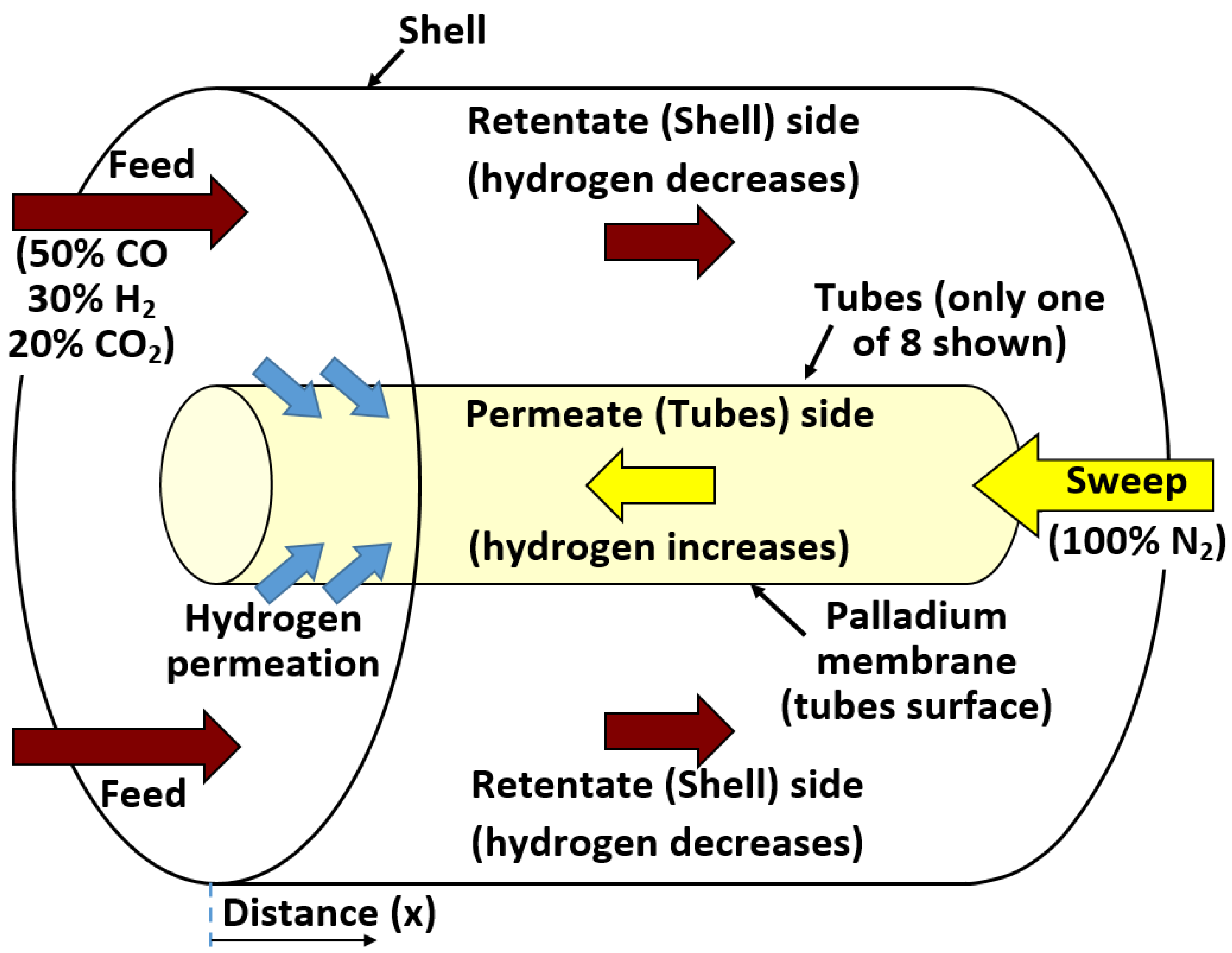

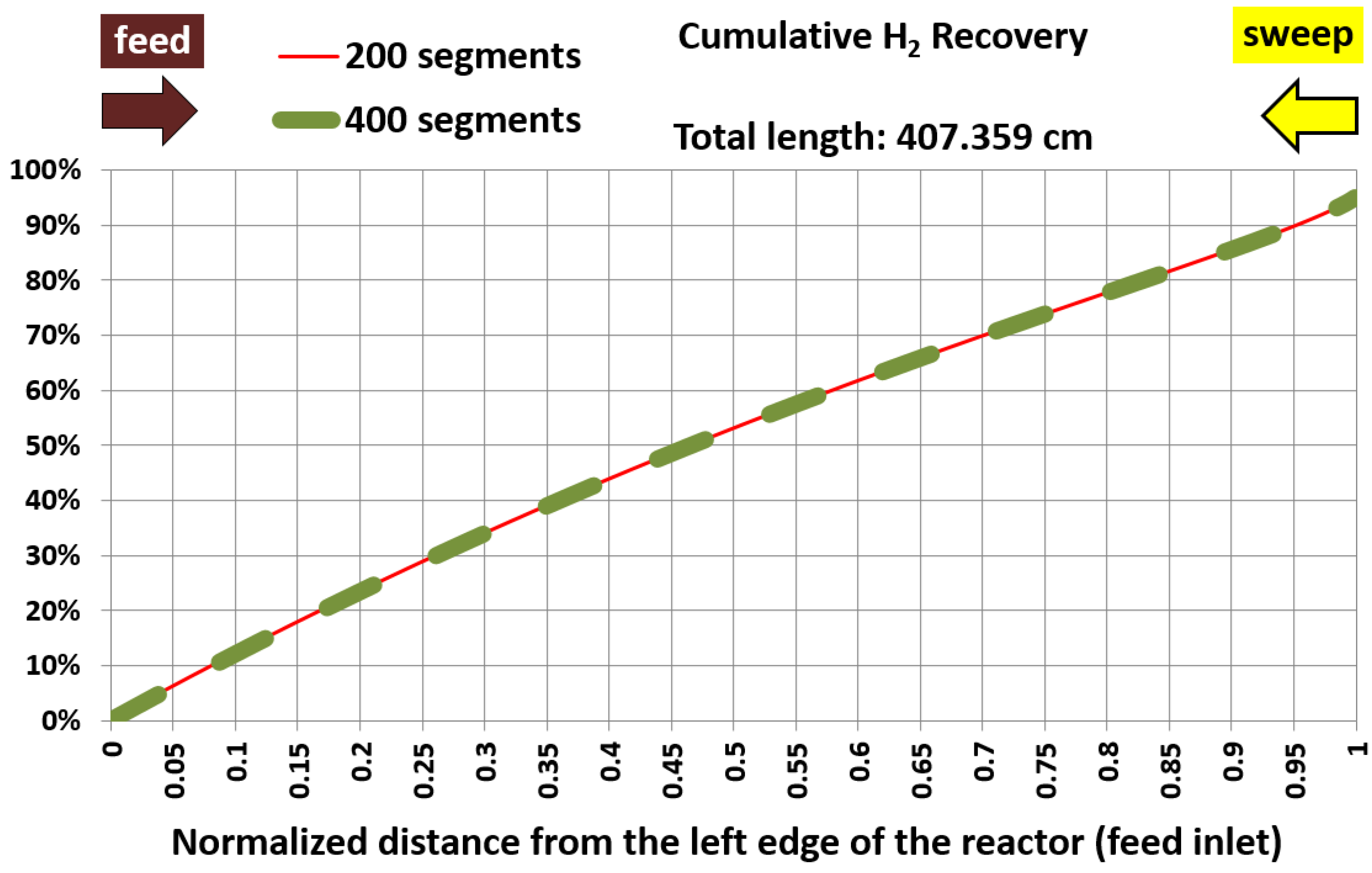
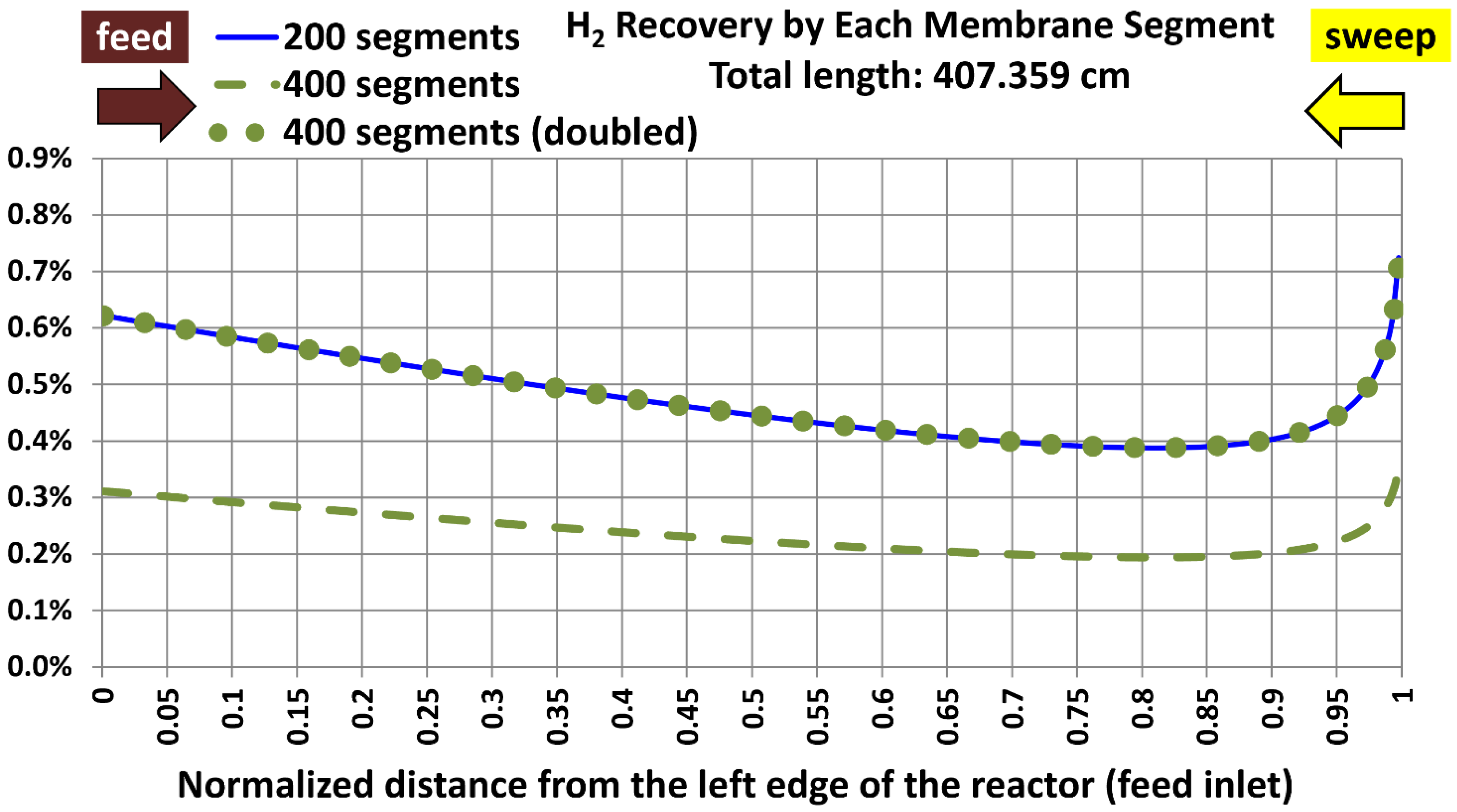

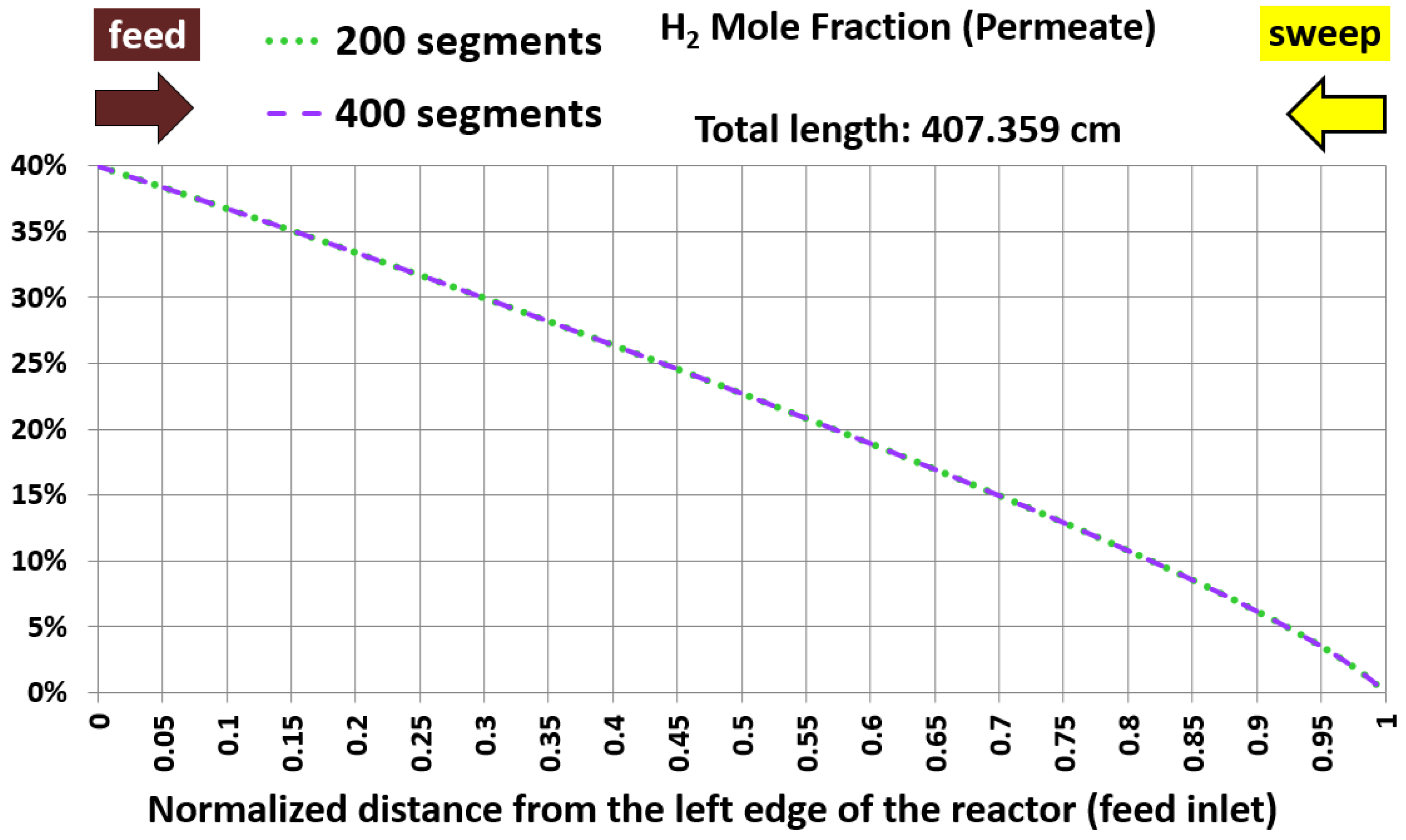

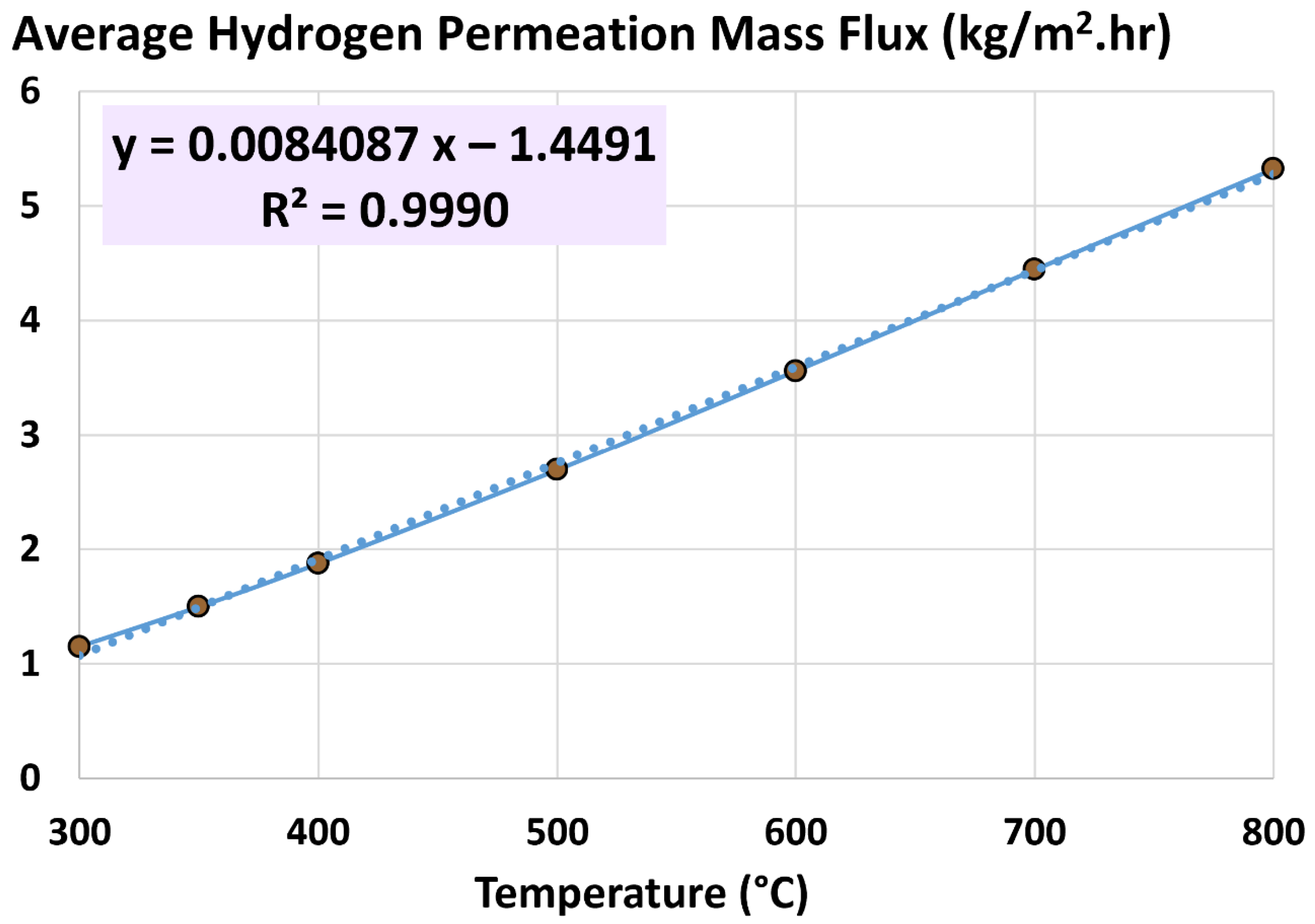




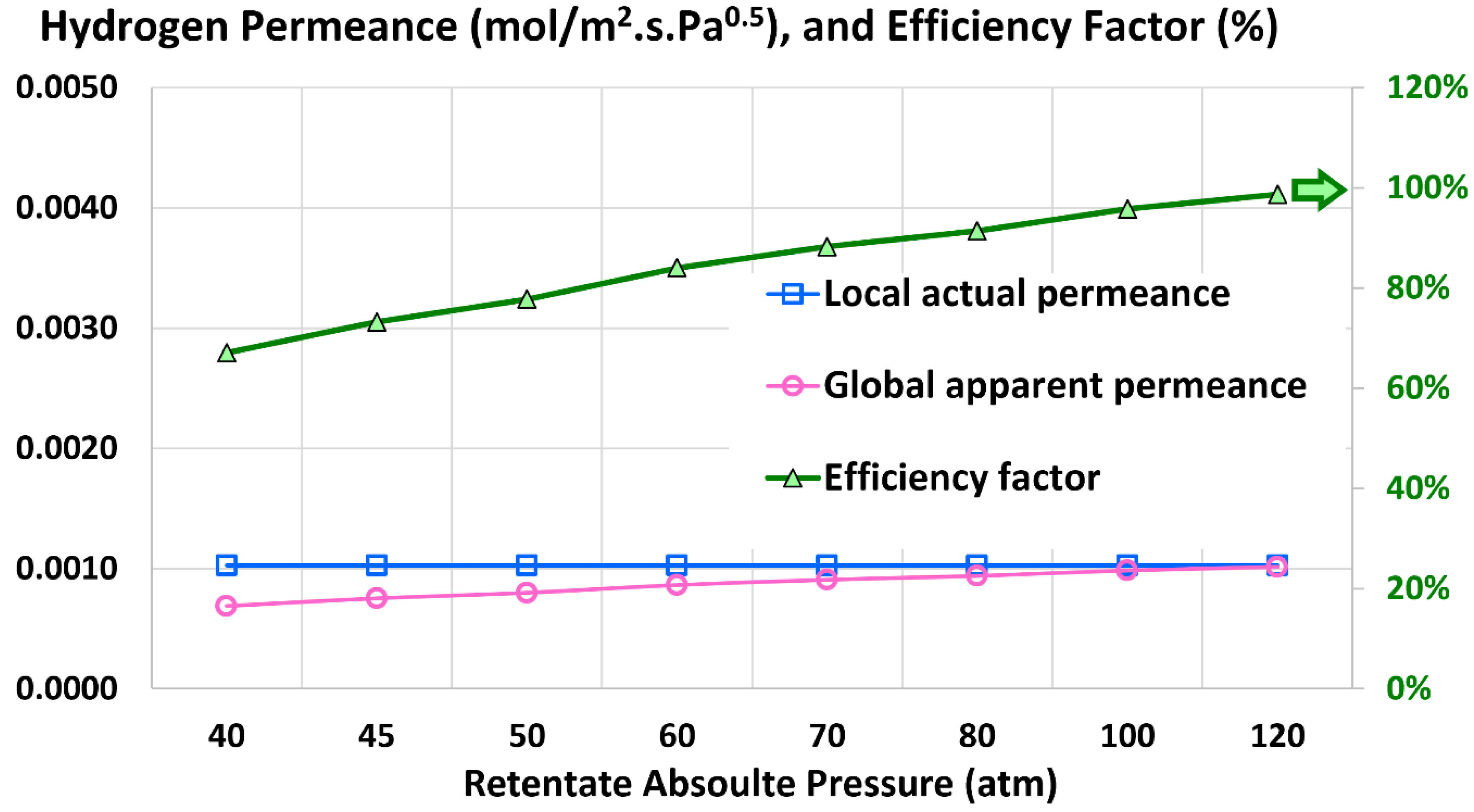

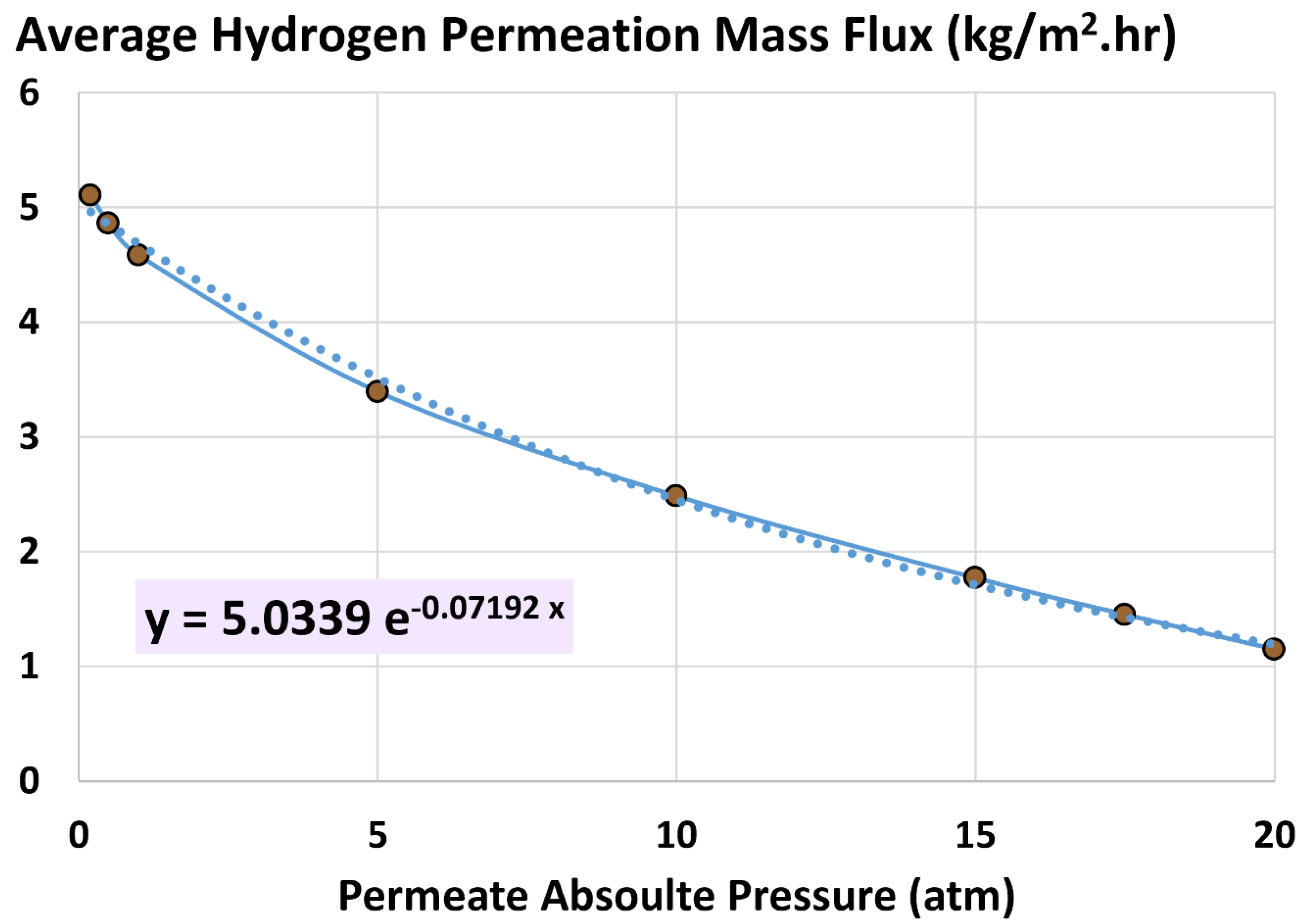
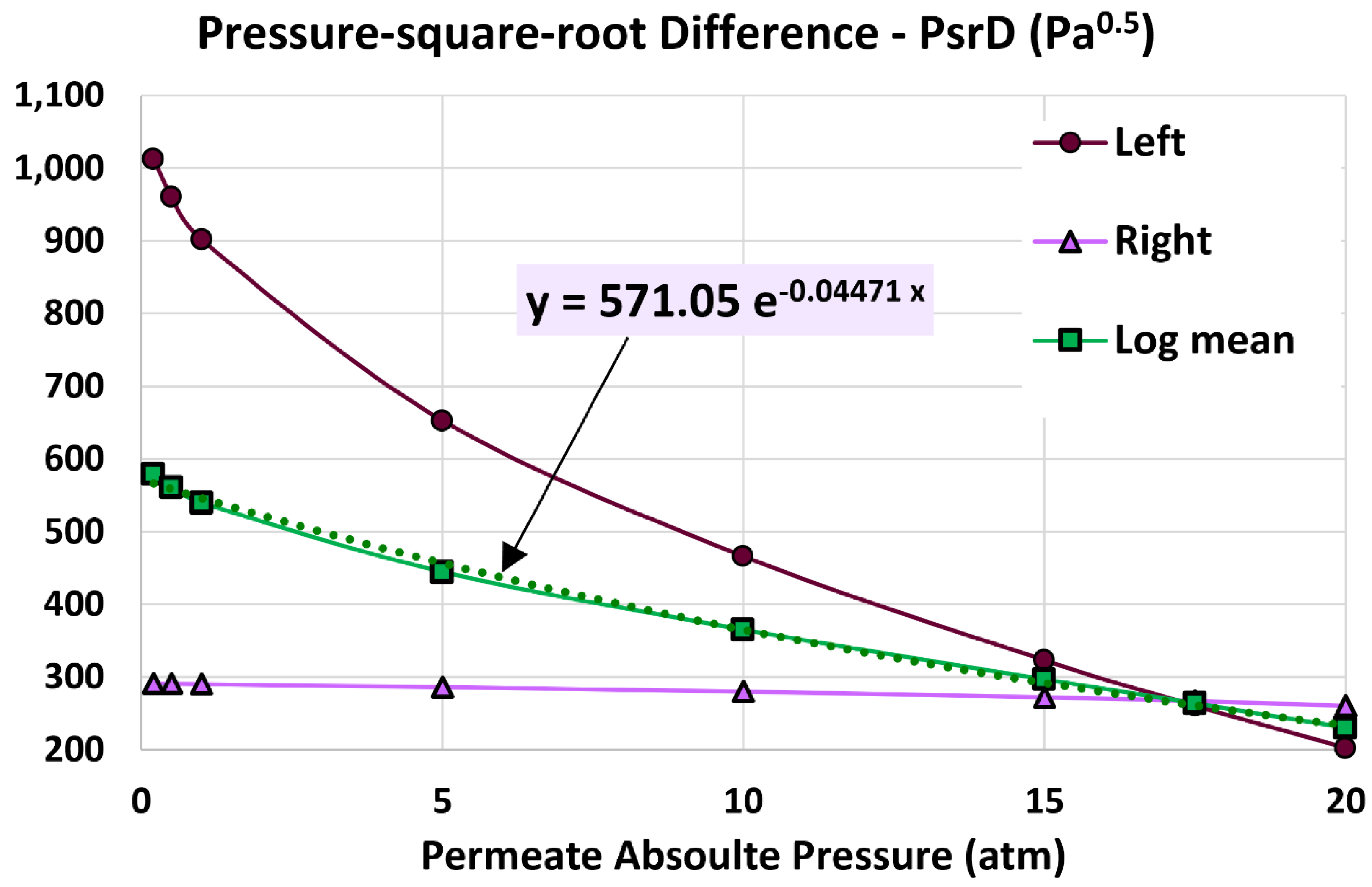
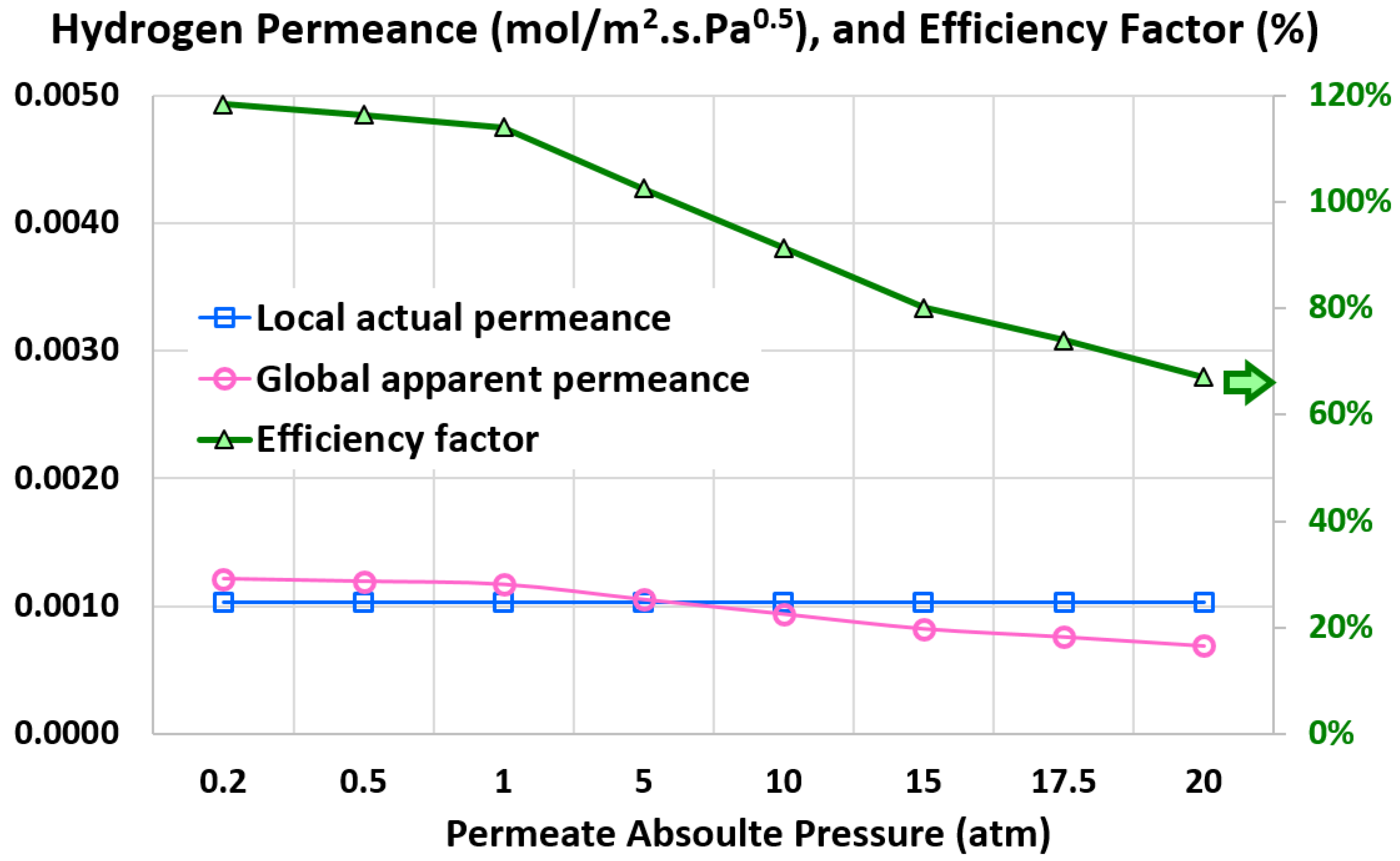
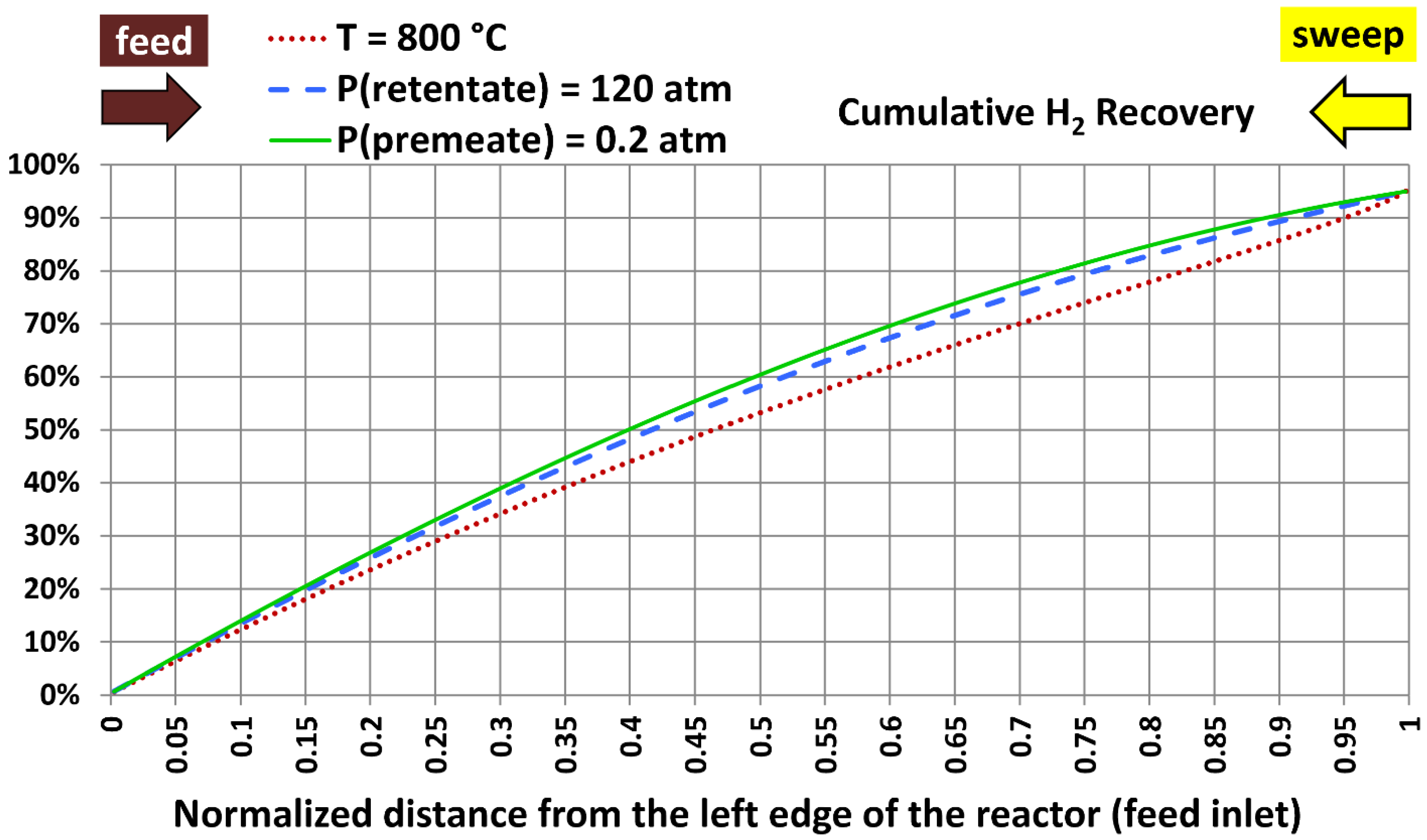
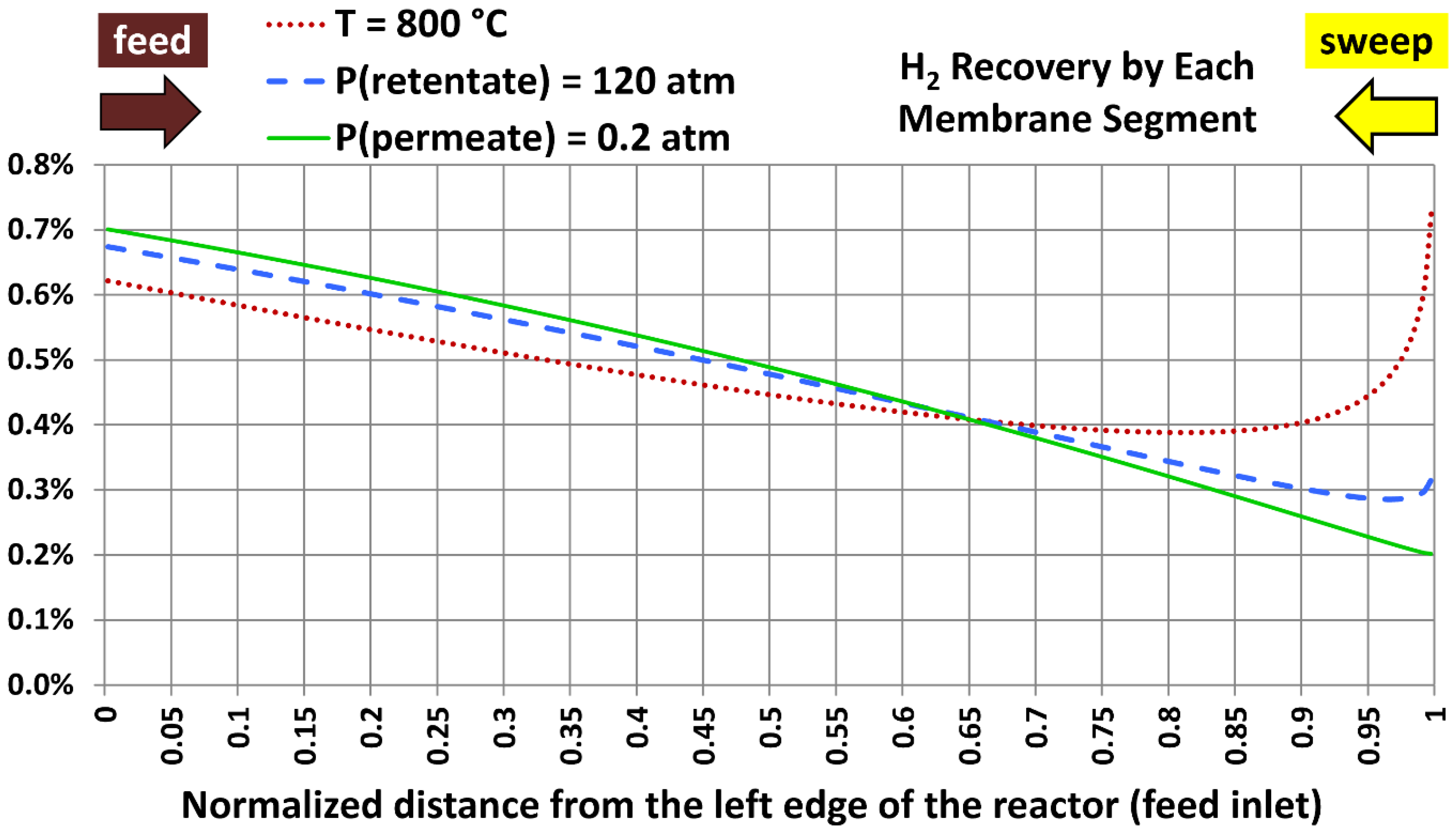
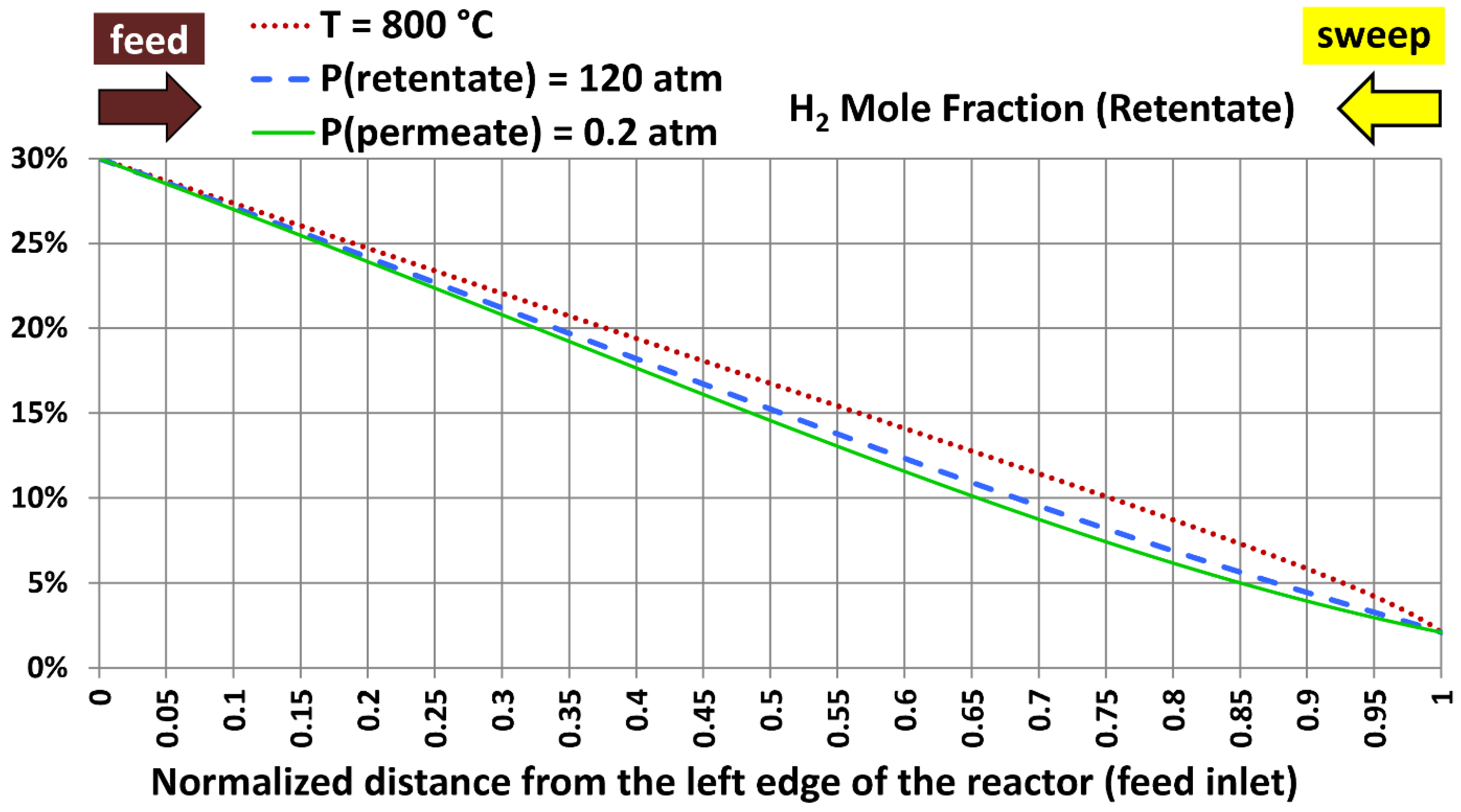
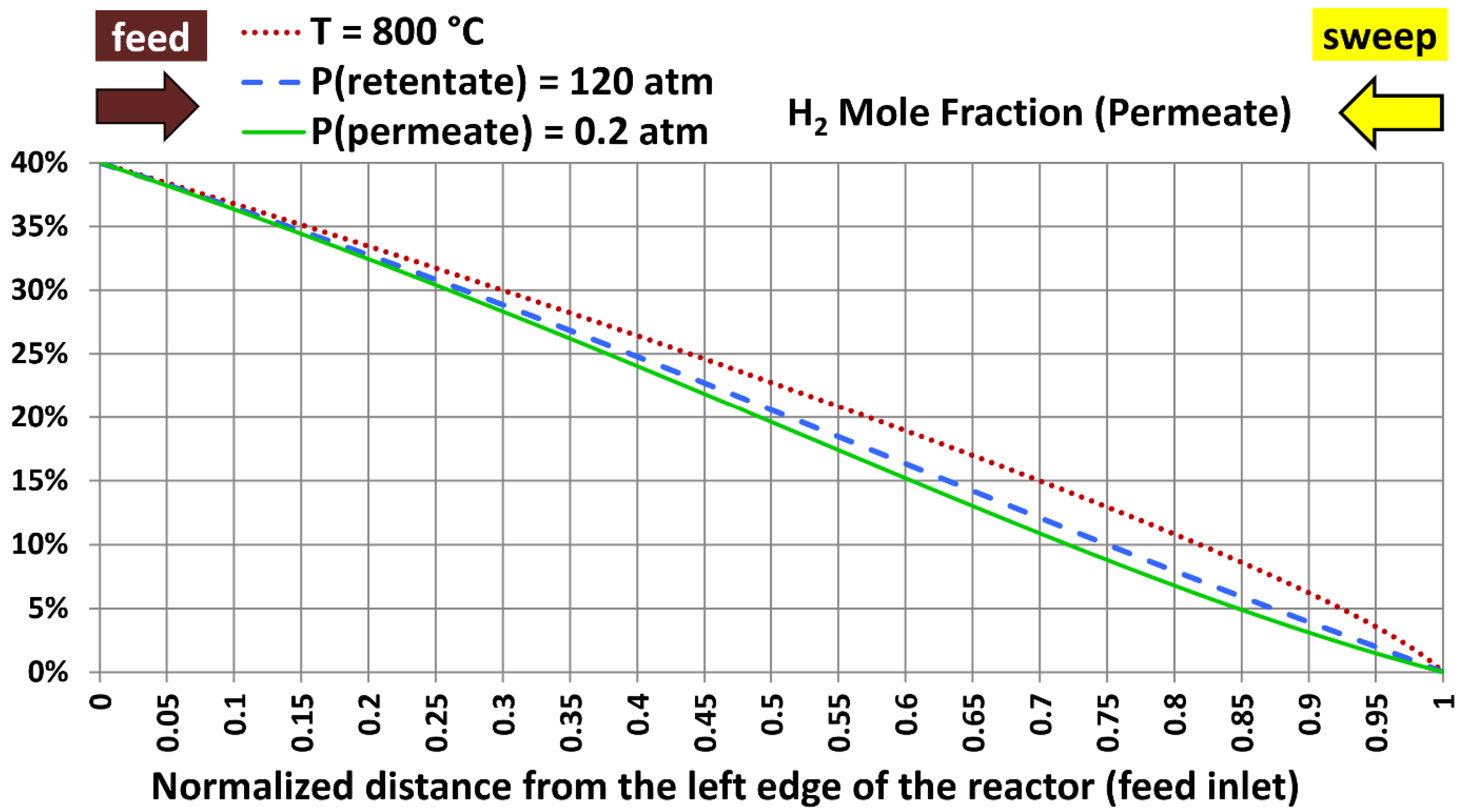
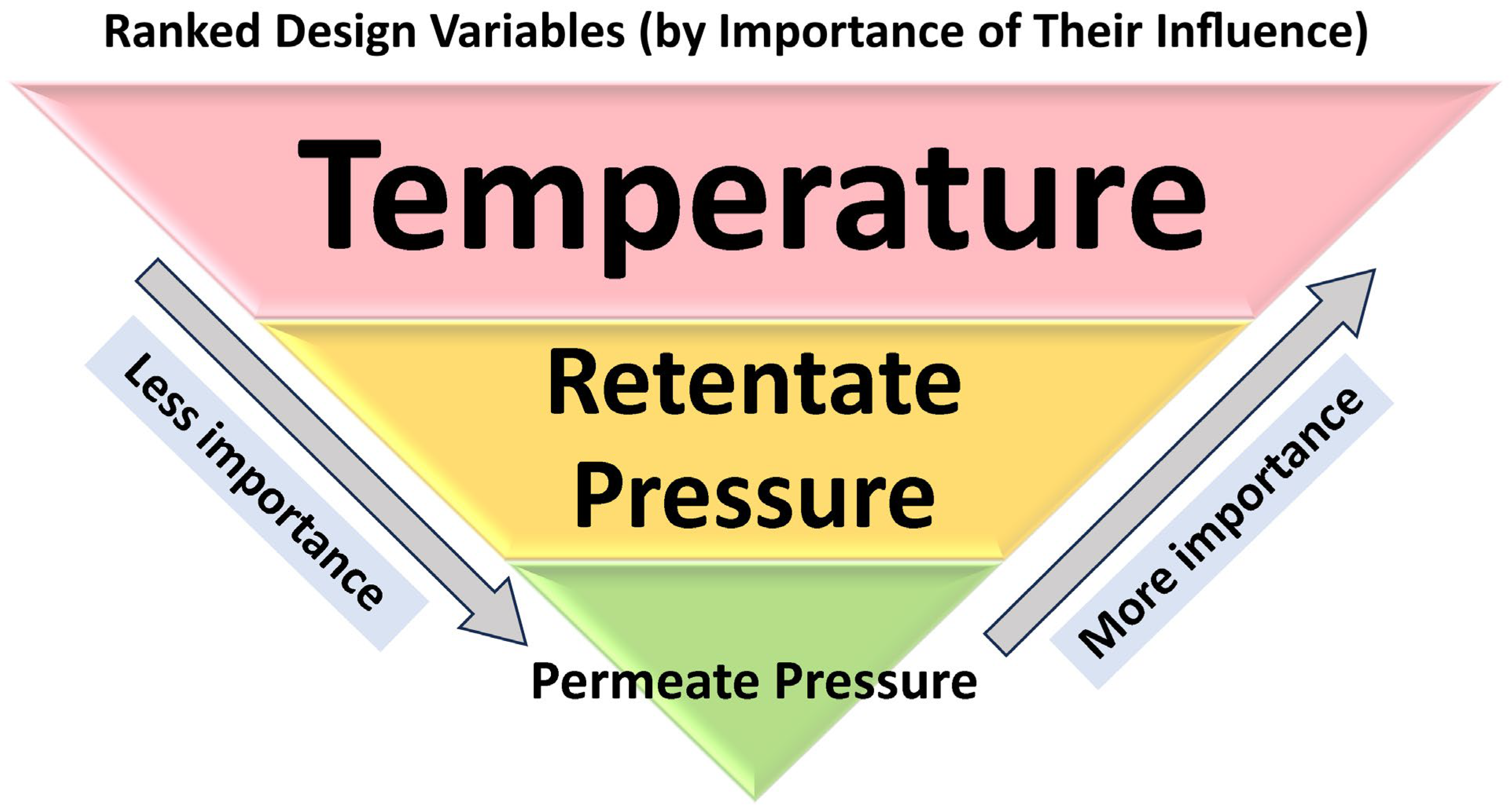
| Geometric Feature | Value |
|---|---|
| Shell diameter | 5.000 cm (1.969 in) |
| Tube diameter | 1.250 cm (0.4921 in) |
| Number of tubes | 8 |
| Shell cross-section area (excluding tubes) | 9.817 cm2 (1.522 in2) |
| Tubes cross-section area (all 8 tubes) | 9.817 cm2 (1.522 in2) |
| Shell-to-tubes area ratio | 1:1 |
| Tube cross-section area (single tube) | 1.227 cm2 (0.1902 in2) |
| Condition | Value |
|---|---|
| Inlet mole fraction, H2 | 30% [254] |
| Inlet mole fraction, CO | 50% [255] |
| Inlet mole fraction, CO2 | 20% [256,257] |
| Molecular weight, H2 | 2.01588 kg/kmol [258] |
| Molecular weight, CO | 28.0101 kg/kmol [259] |
| Molecular weight, CO2 | 44.0095 kg/kmol [260] |
| Molecular weight, mixture | 23.412 kg/kmol |
| Inlet mass fraction, H2 | 0.025832 |
| Inlet mass fraction, CO | 0.598207 |
| Inlet mass fraction, CO2 | 0.375961 |
| Inlet mass flow rate | 60 kg/h (132.28 lbm/h) |
| Inlet standard volume flow rate | 970,068 sccm (standard cubic centimeters per minute) |
| Target hydrogen recovery | 95% (by mass, by mole, or by standard volume—identical) |
| Condition | Value |
|---|---|
| Inlet gas | 100% N2 |
| Molecular weight, N2 | 28.0134 kg/kmol [287] |
| Inlet mass flow rate | 30.692 kg/h (67.664 lbm/h) |
| Inlet standard volume flow rate | 414,704 sccm (standard cubic centimeters per minute) |
| Target outlet mole fraction of H2 | 40% |
| Fluid Property | Value |
|---|---|
| Temperature | 300 °C (572.00 °F) |
| Absolute retentate pressure | 40.0 atm (587.84 psia) |
| Absolute permeate pressure | 20.0 atm (293.92 psia) |
| Result | Value | Absolute Percentage Change | |
|---|---|---|---|
| n = 200 Segments | n = 400 Segments | ||
| Membrane length (cm) | 407.359 | 407.359 | 0% (identical) |
| Average hydrogen permeation mass flux (kg/m2.h) | 1.151 | 1.150 | 0.01% |
| Pressure-square-root difference at left end (Pa0.5) | 202.345 | 202.345 | 0% (identical) |
| Pressure-square-root difference at right end (Pa0.5) | 260.655 | 268.896 | 3.16% |
| Log mean pressure-square-root difference (Pa0.5) | 230.271 | 234.05 | 1.64% |
| Global apparent hydrogen permeance (mol/m2.s.Pa0.5) | 6.8849 × 10−4 | 6.7732 × 10−4 | 1.62% |
| Efficiency factor (%) | 67.09% | 66.00% | 1.62% |
| Hydrogen recovery (%) | 95.000% | 94.991% | 0.01% |
| Extreme Case Number | Temperature | Absolute Retentate Pressure | Absolute Permeate Pressure |
|---|---|---|---|
| 1 | 800 °C (1472.00 °F) | 40.0 atm (587.84 psia) | 20.0 atm (293.92 psia) |
| 2 | 300 °C (572.00 °F) | 120.0 atm (1763.5 psia) | 20.0 atm (293.92 psia) |
| 3 | 300 °C (572.00 °F) | 40.0 atm (587.84 psia) | 0.20 atm (2.9392 psia) |
Disclaimer/Publisher’s Note: The statements, opinions and data contained in all publications are solely those of the individual author(s) and contributor(s) and not of MDPI and/or the editor(s). MDPI and/or the editor(s) disclaim responsibility for any injury to people or property resulting from any ideas, methods, instructions or products referred to in the content. |
© 2025 by the author. Licensee MDPI, Basel, Switzerland. This article is an open access article distributed under the terms and conditions of the Creative Commons Attribution (CC BY) license (https://creativecommons.org/licenses/by/4.0/).
Share and Cite
Marzouk, O.A. Reduced-Order Modeling (ROM) of a Segmented Plug-Flow Reactor (PFR) for Hydrogen Separation in Integrated Gasification Combined Cycles (IGCC). Processes 2025, 13, 1455. https://doi.org/10.3390/pr13051455
Marzouk OA. Reduced-Order Modeling (ROM) of a Segmented Plug-Flow Reactor (PFR) for Hydrogen Separation in Integrated Gasification Combined Cycles (IGCC). Processes. 2025; 13(5):1455. https://doi.org/10.3390/pr13051455
Chicago/Turabian StyleMarzouk, Osama A. 2025. "Reduced-Order Modeling (ROM) of a Segmented Plug-Flow Reactor (PFR) for Hydrogen Separation in Integrated Gasification Combined Cycles (IGCC)" Processes 13, no. 5: 1455. https://doi.org/10.3390/pr13051455
APA StyleMarzouk, O. A. (2025). Reduced-Order Modeling (ROM) of a Segmented Plug-Flow Reactor (PFR) for Hydrogen Separation in Integrated Gasification Combined Cycles (IGCC). Processes, 13(5), 1455. https://doi.org/10.3390/pr13051455









